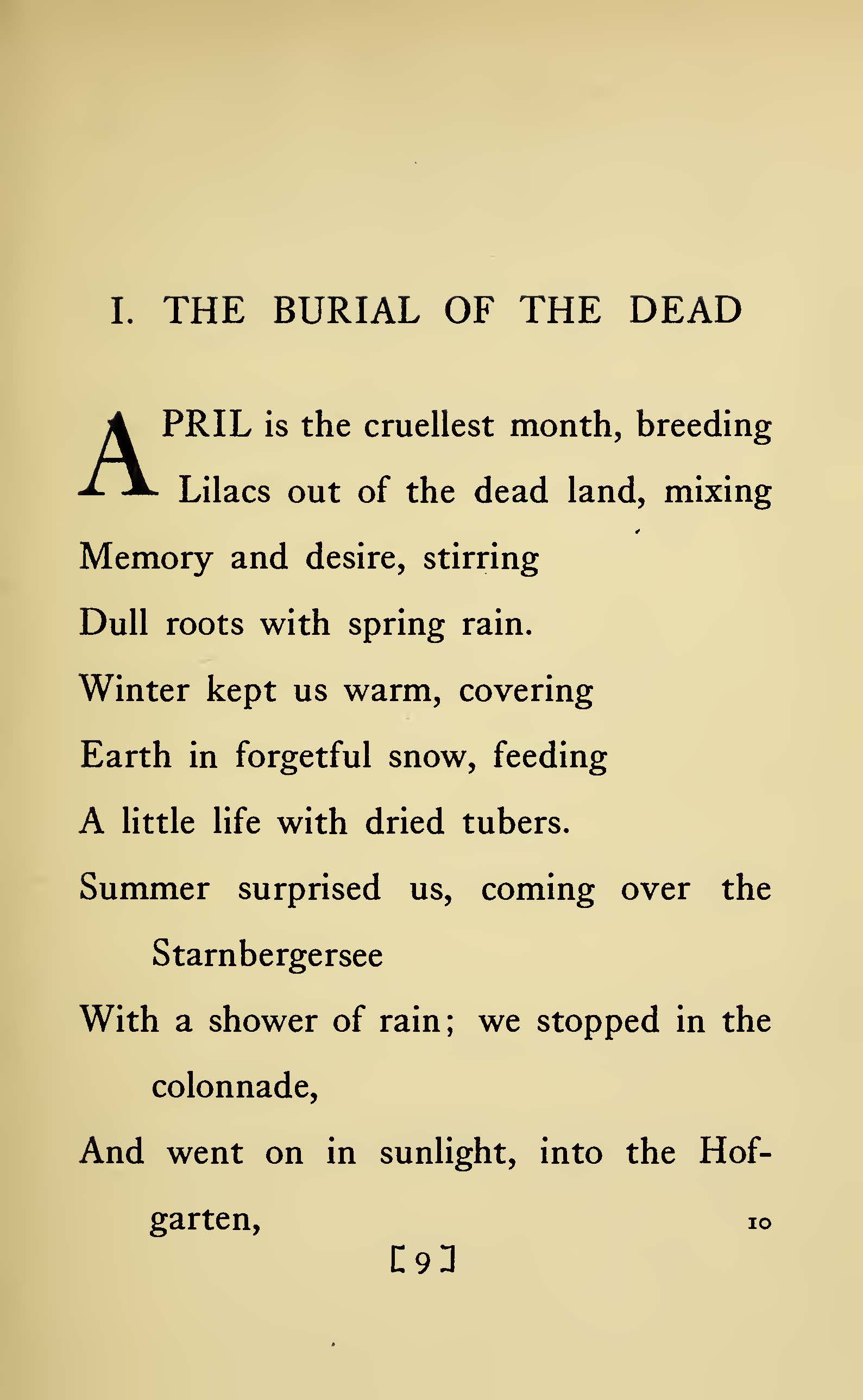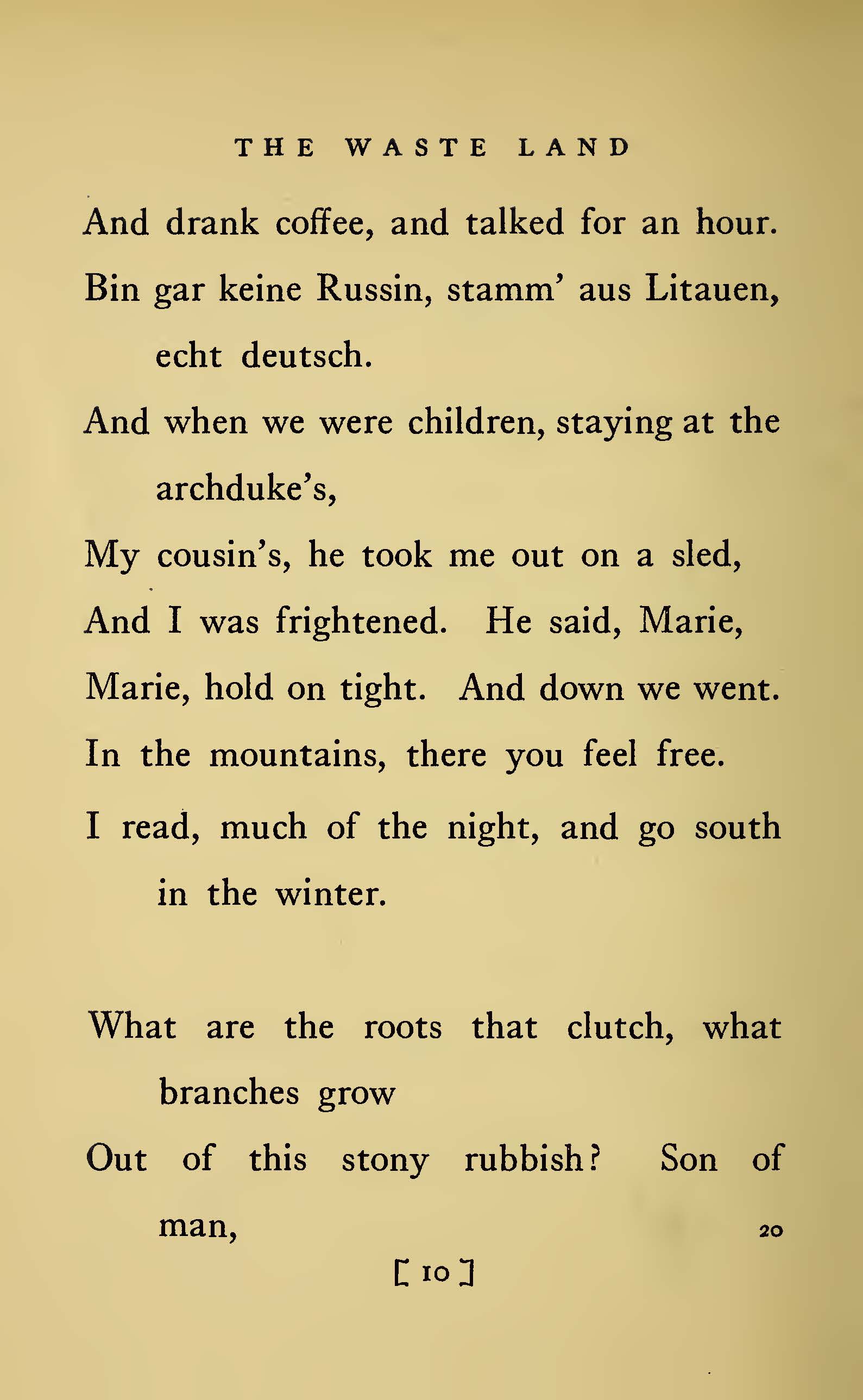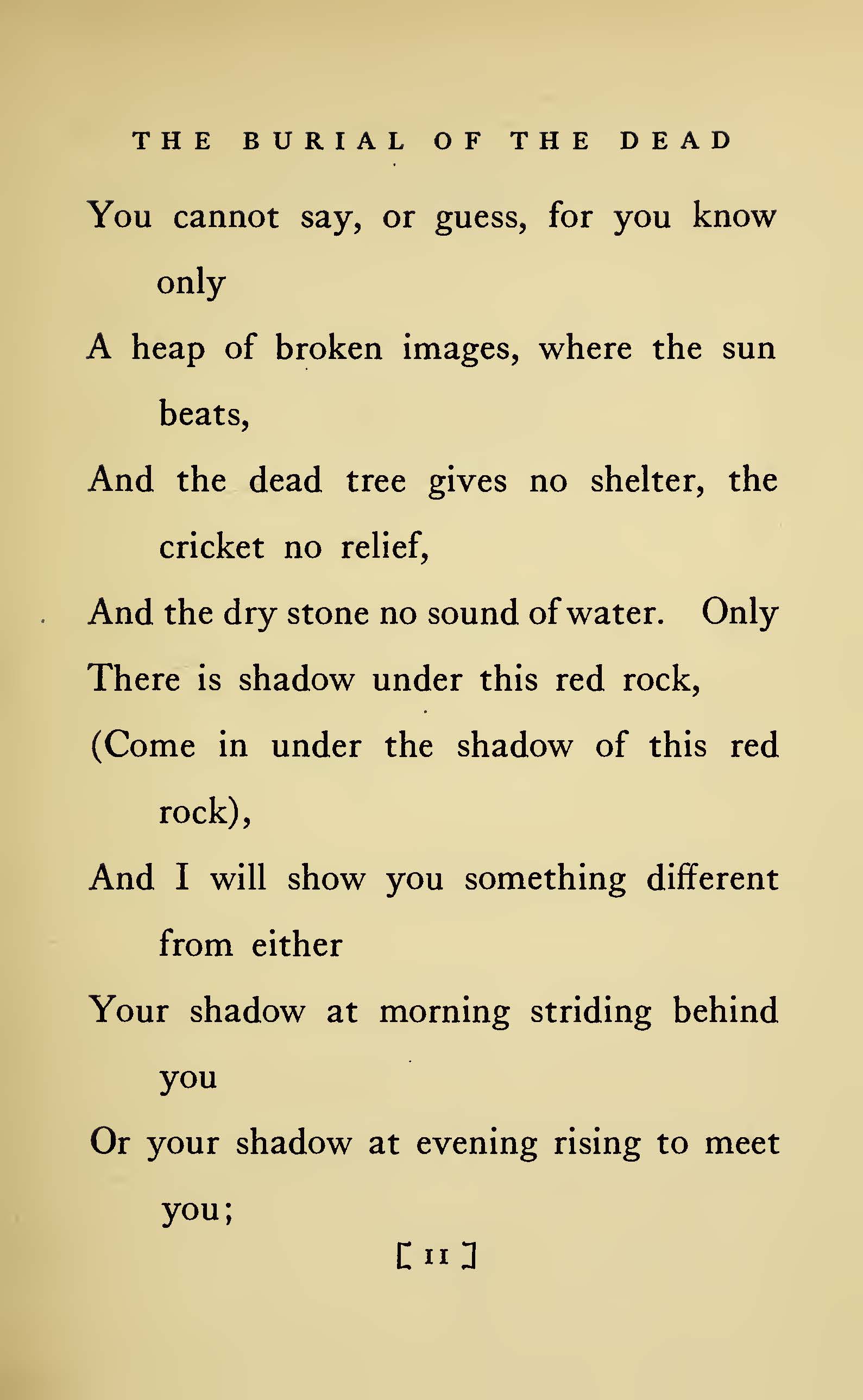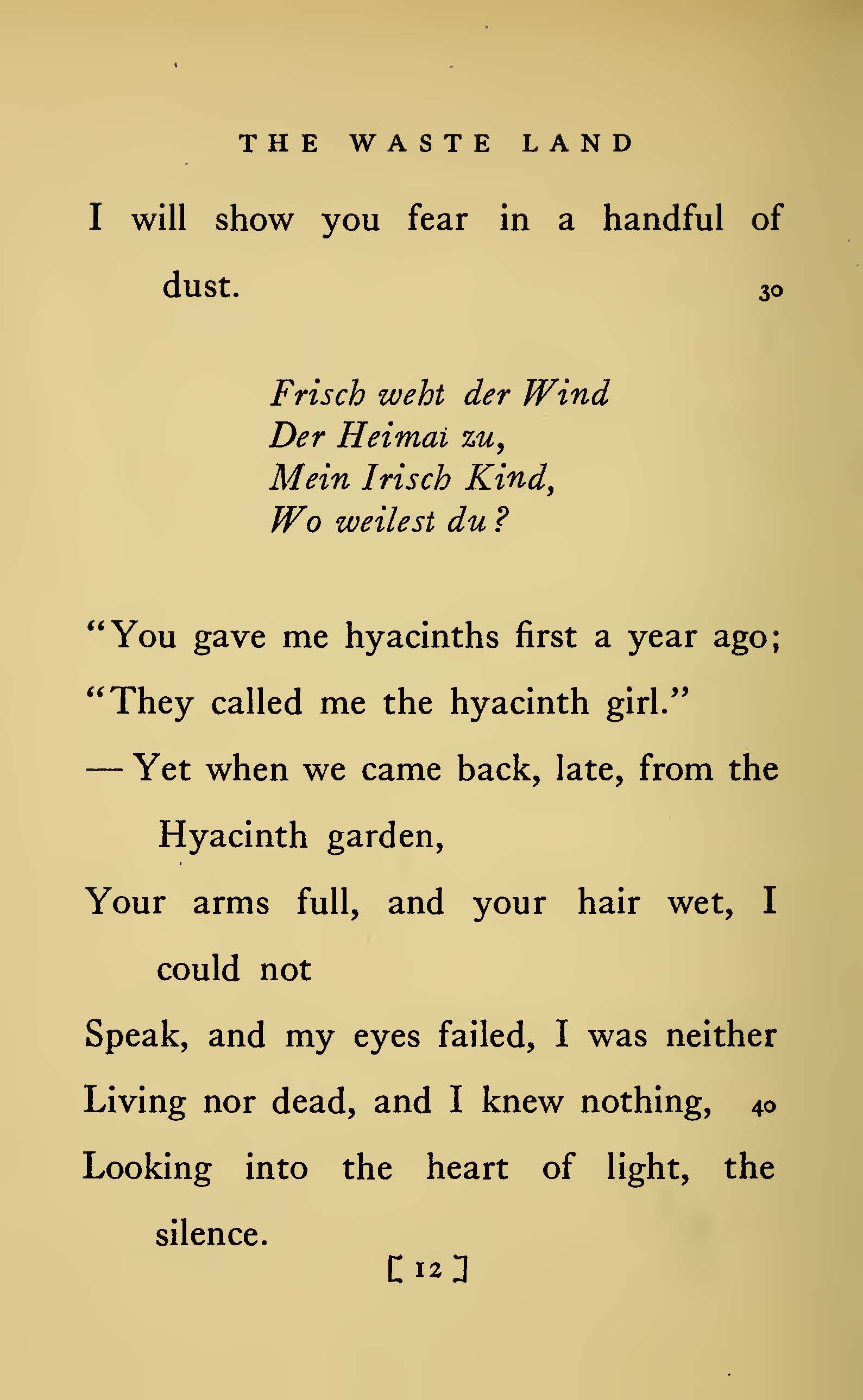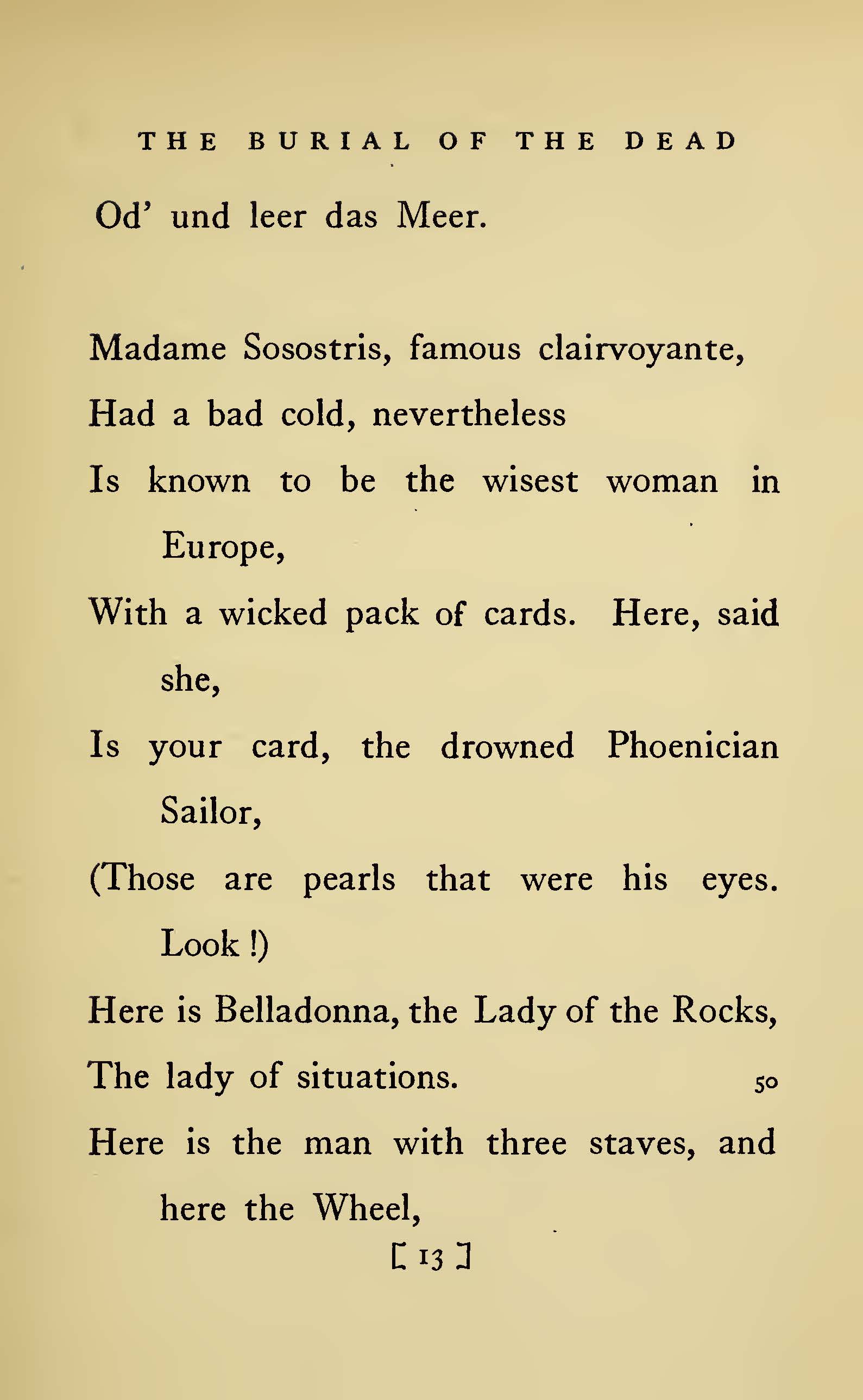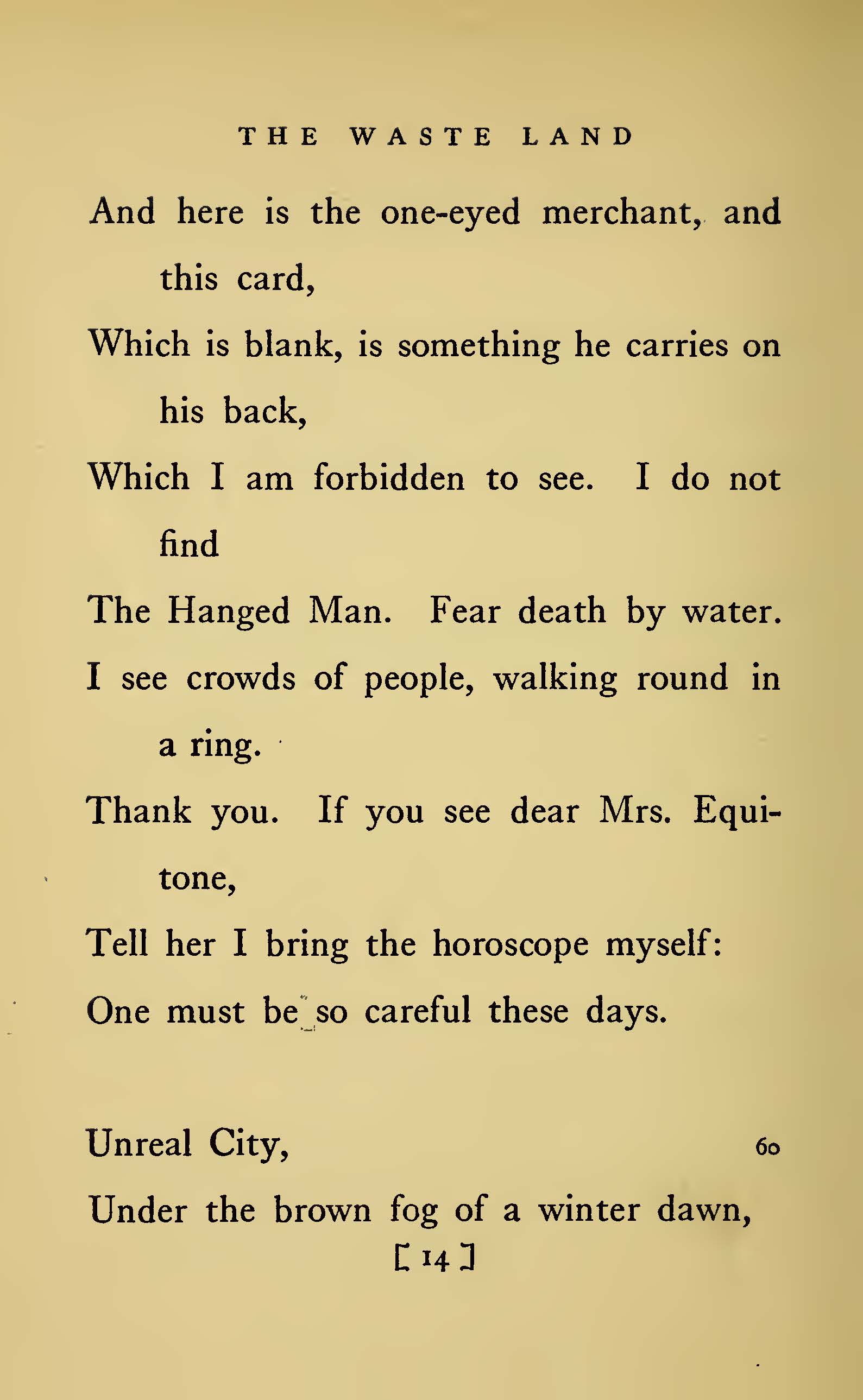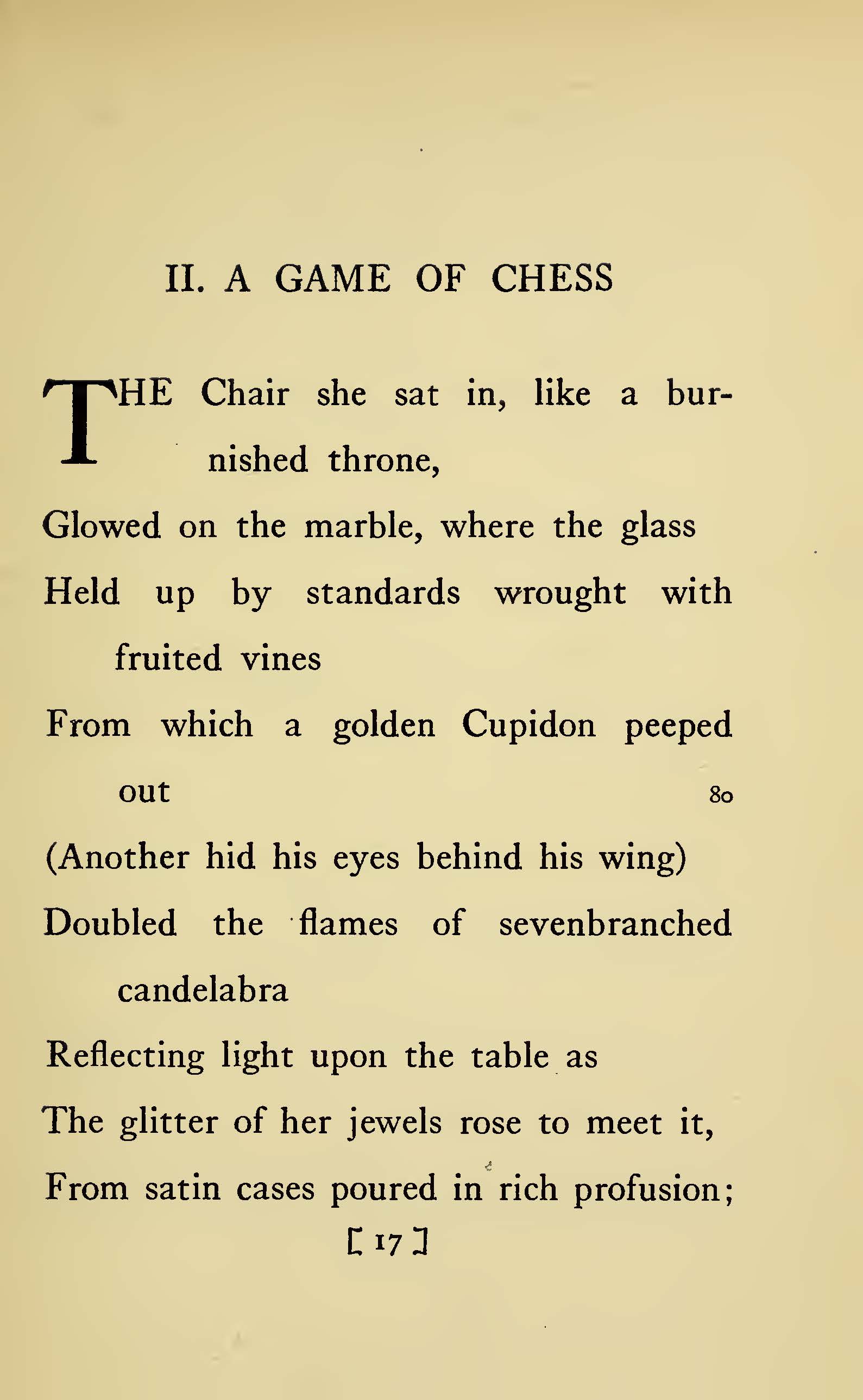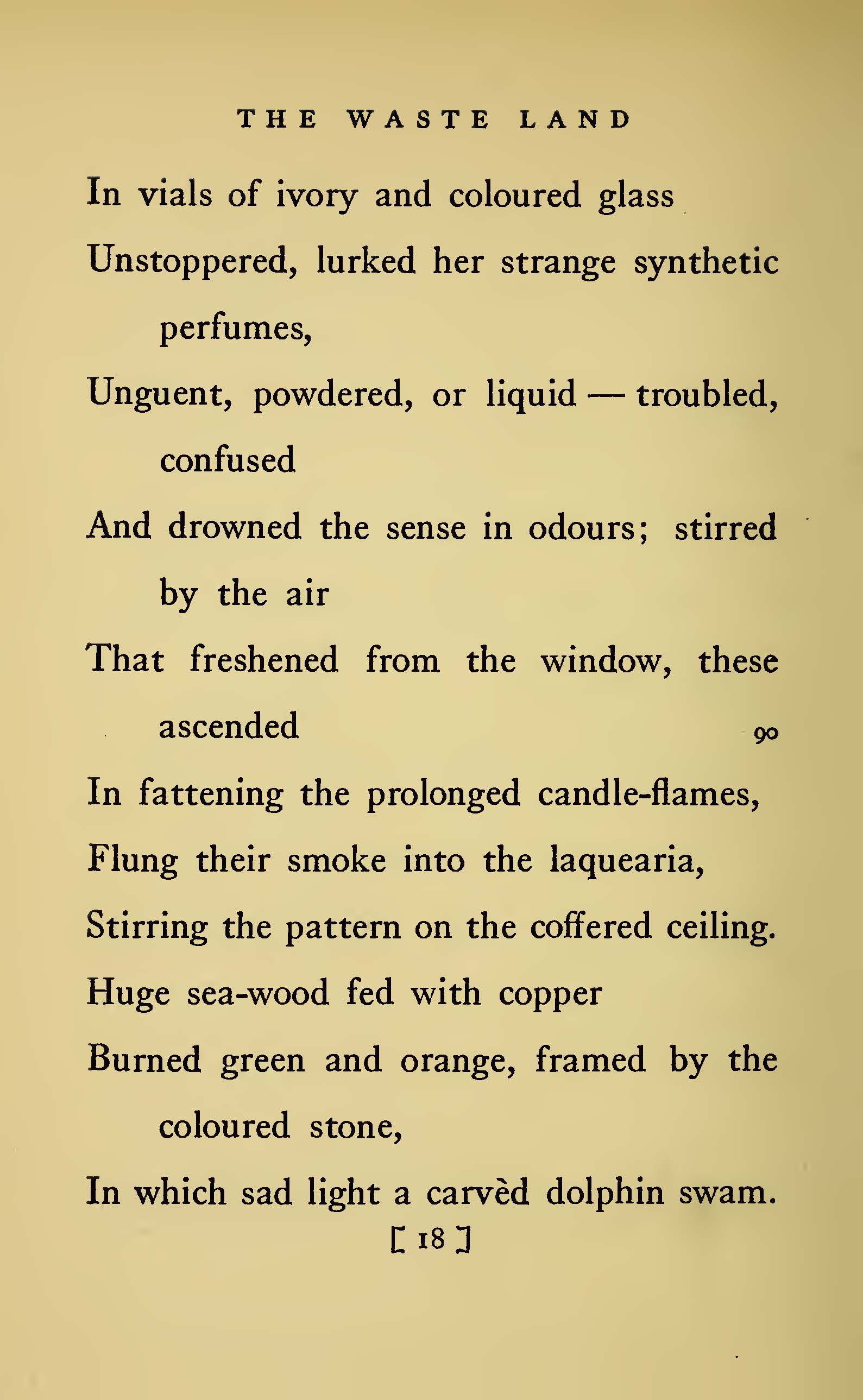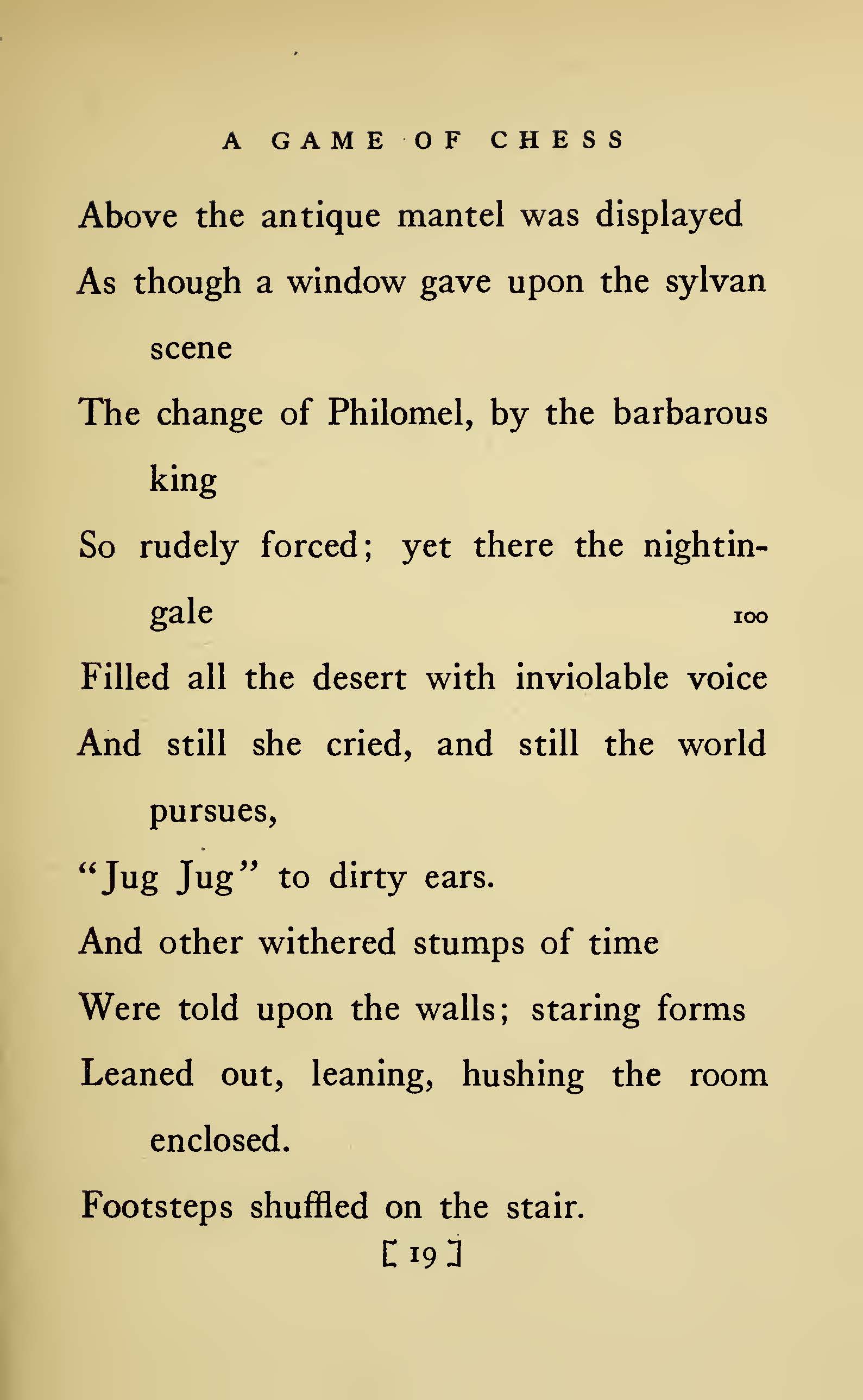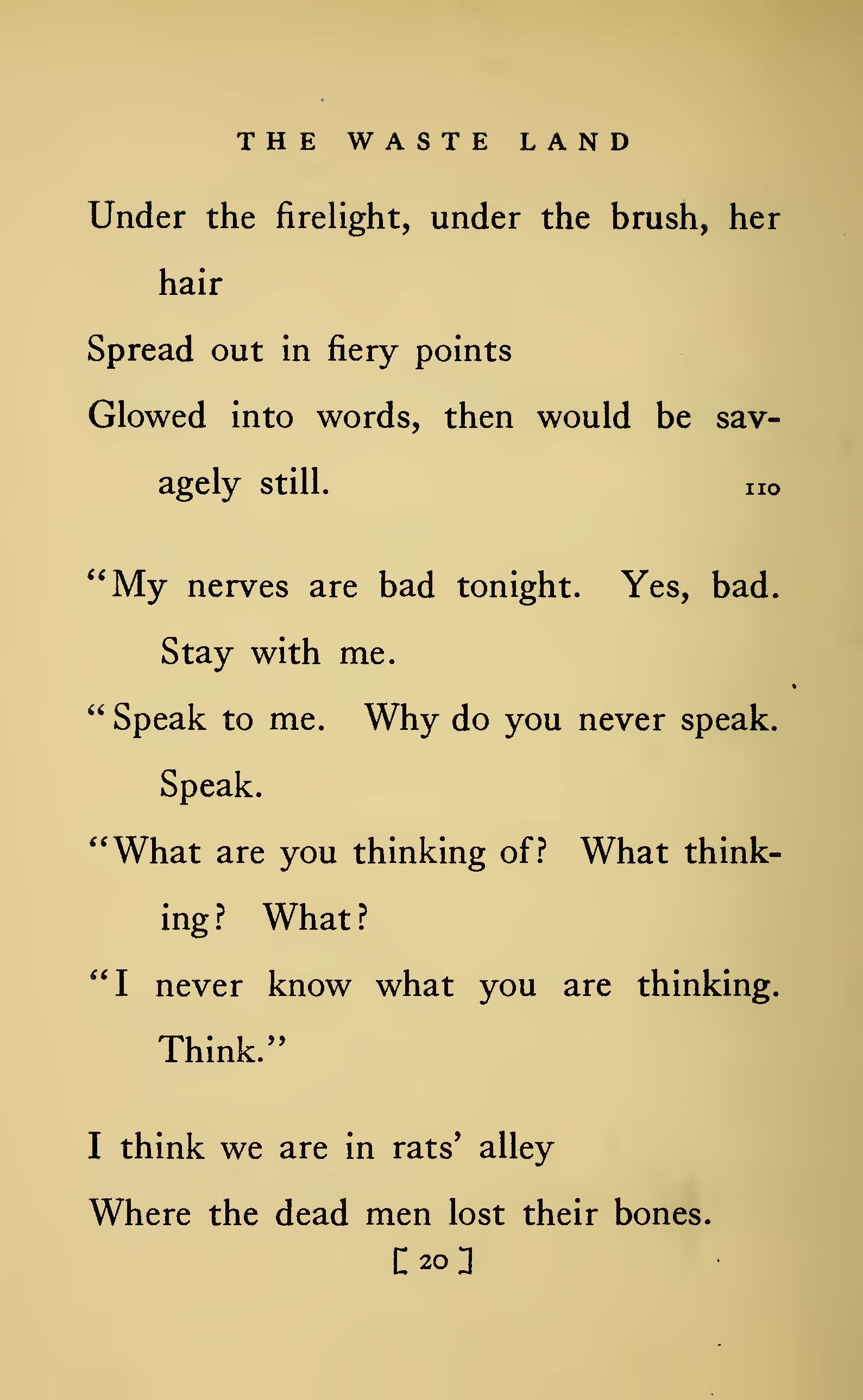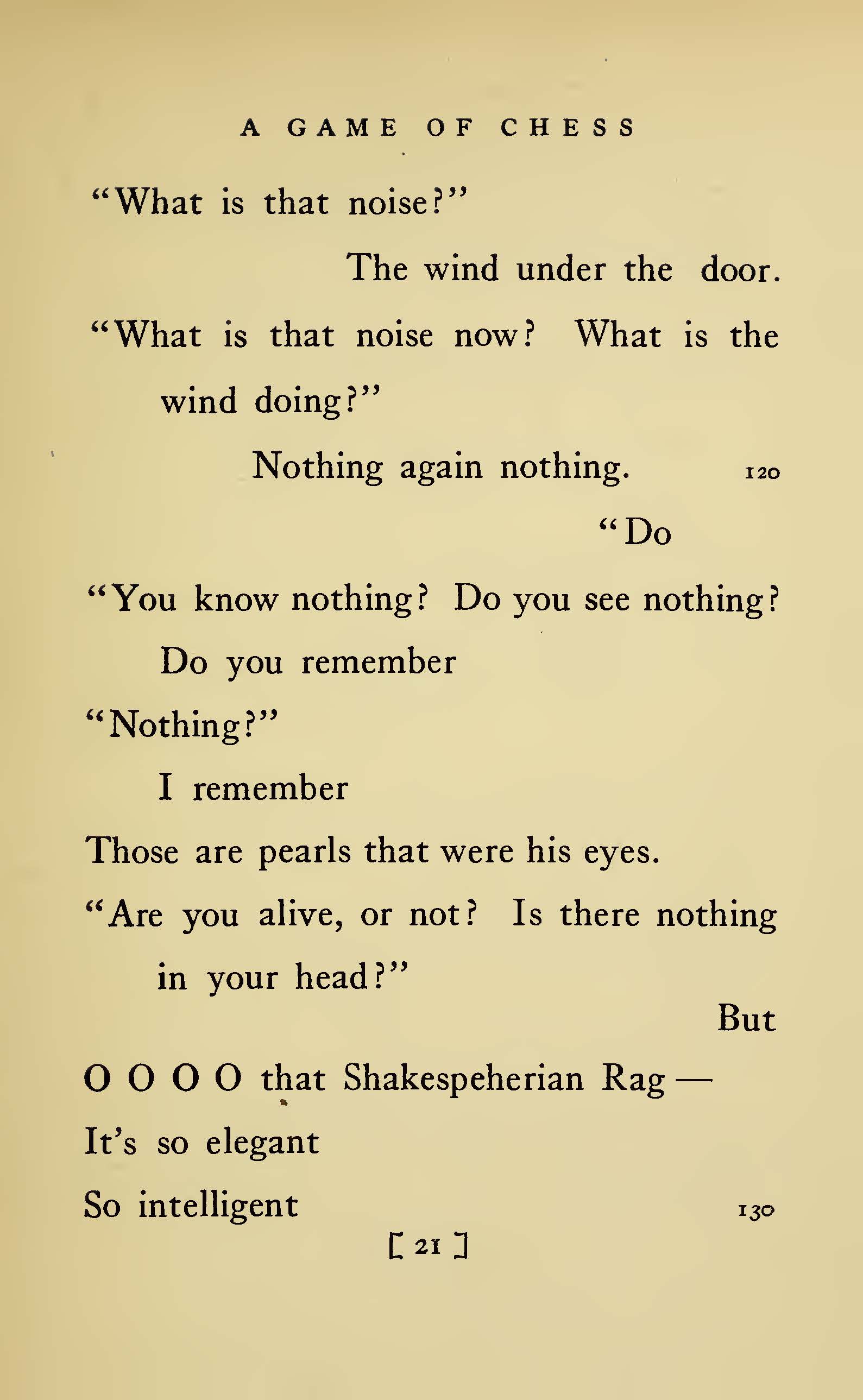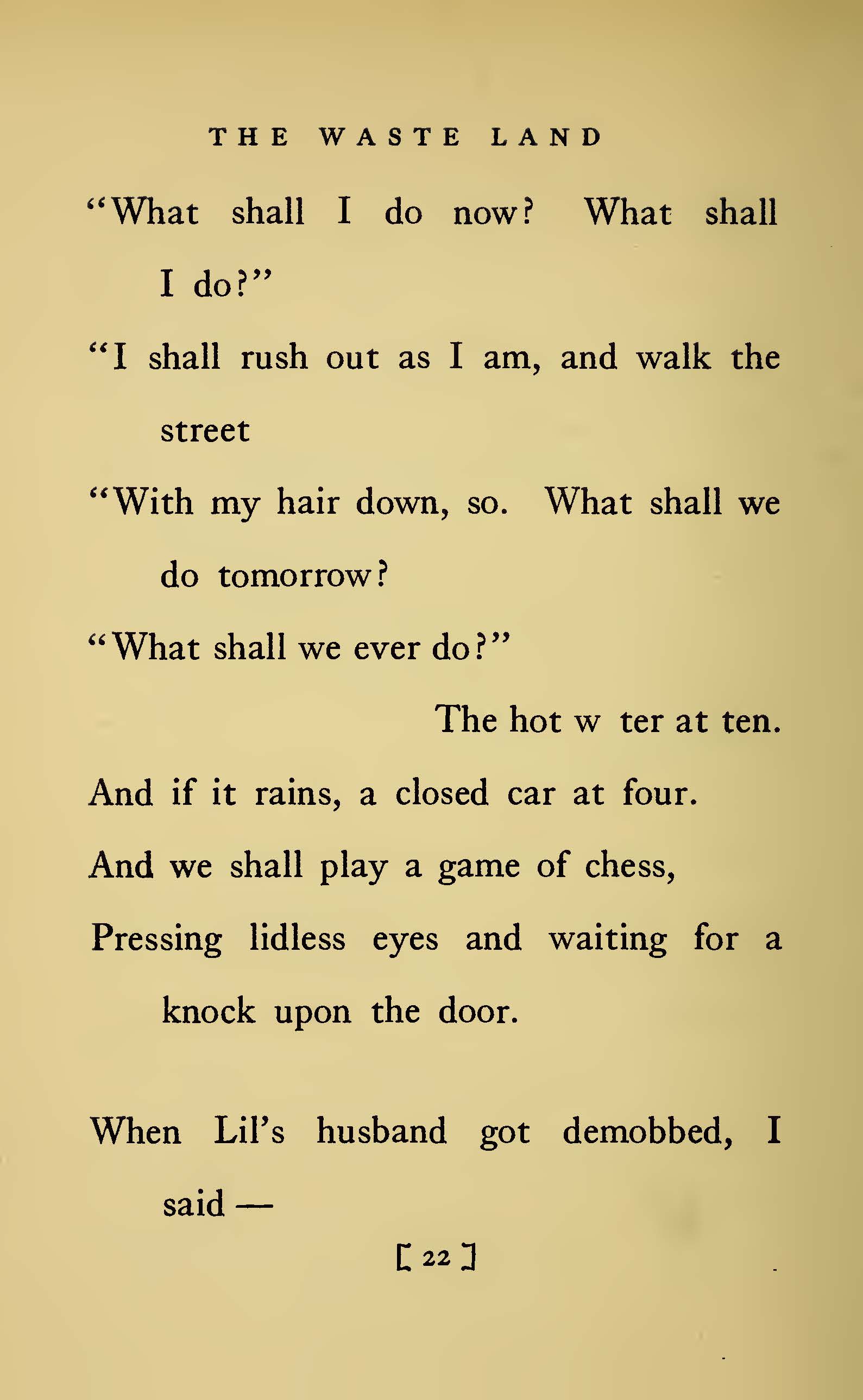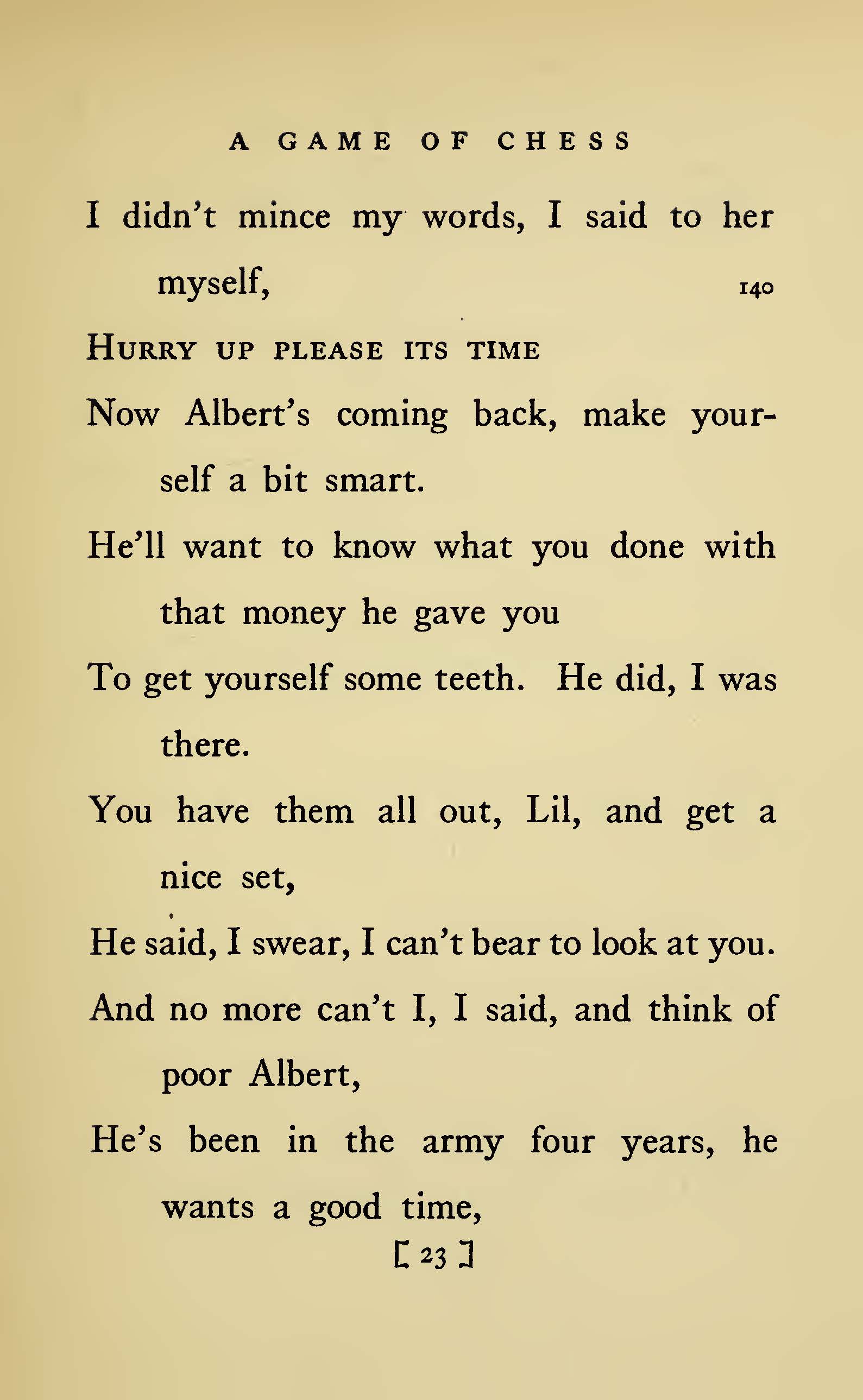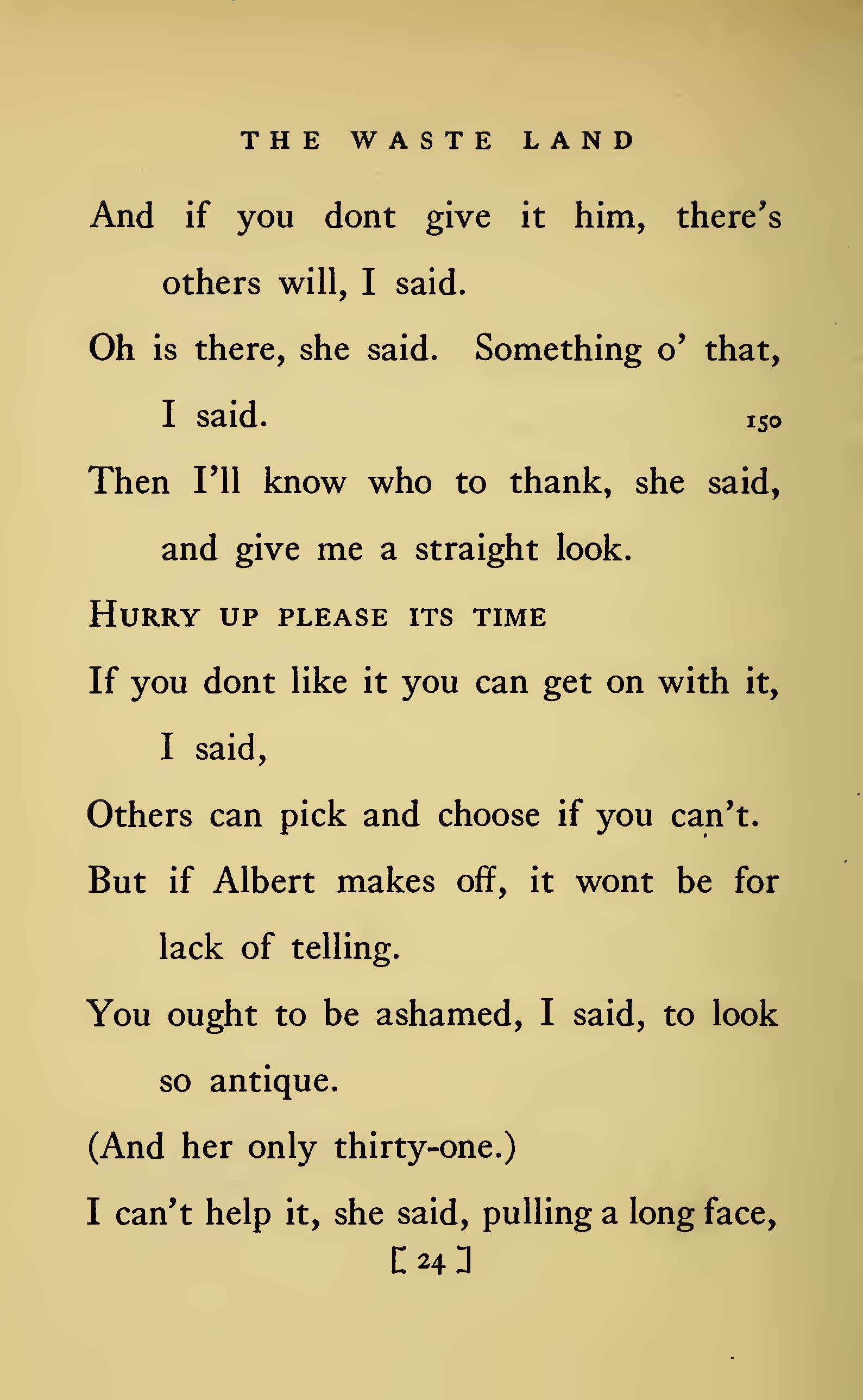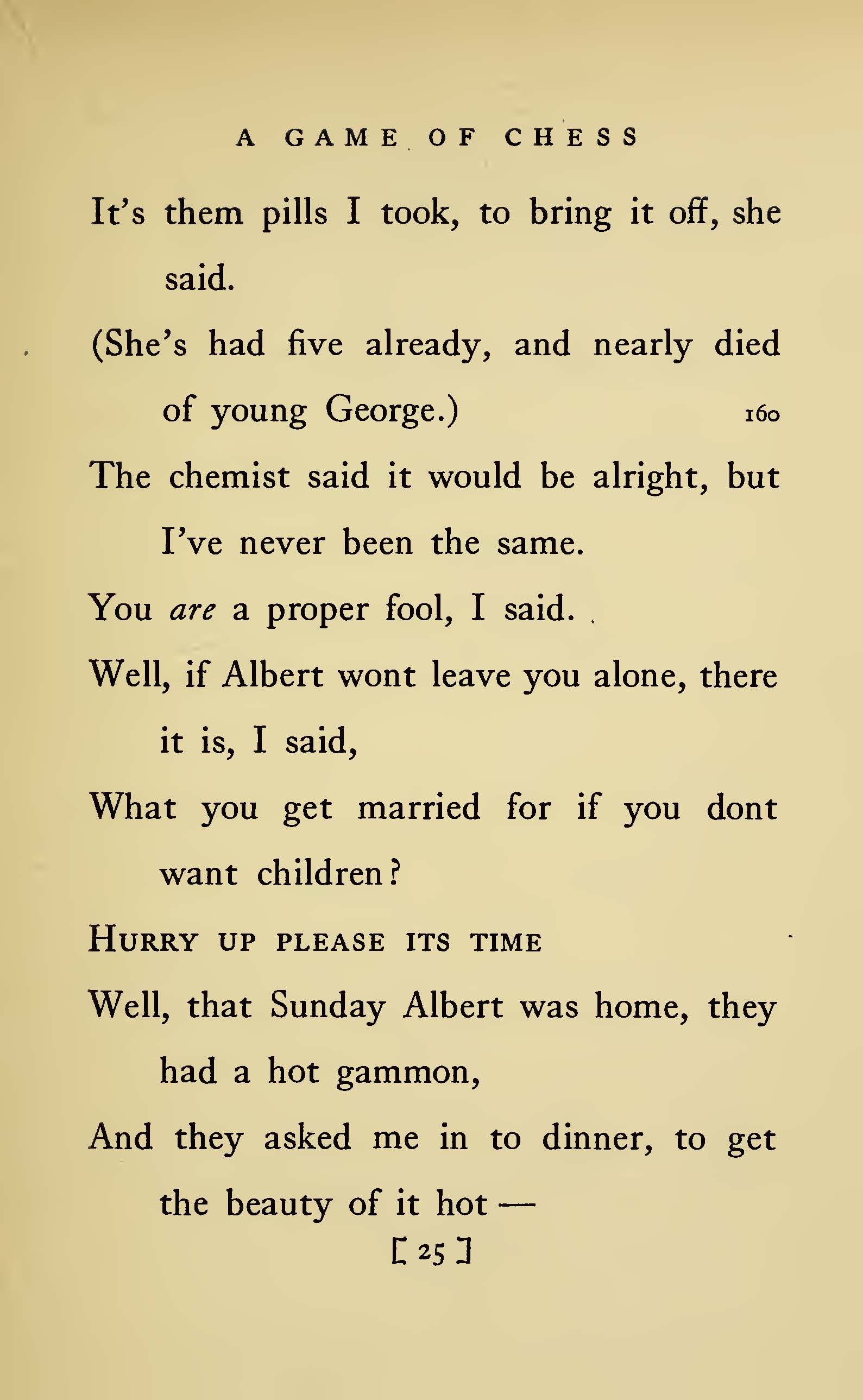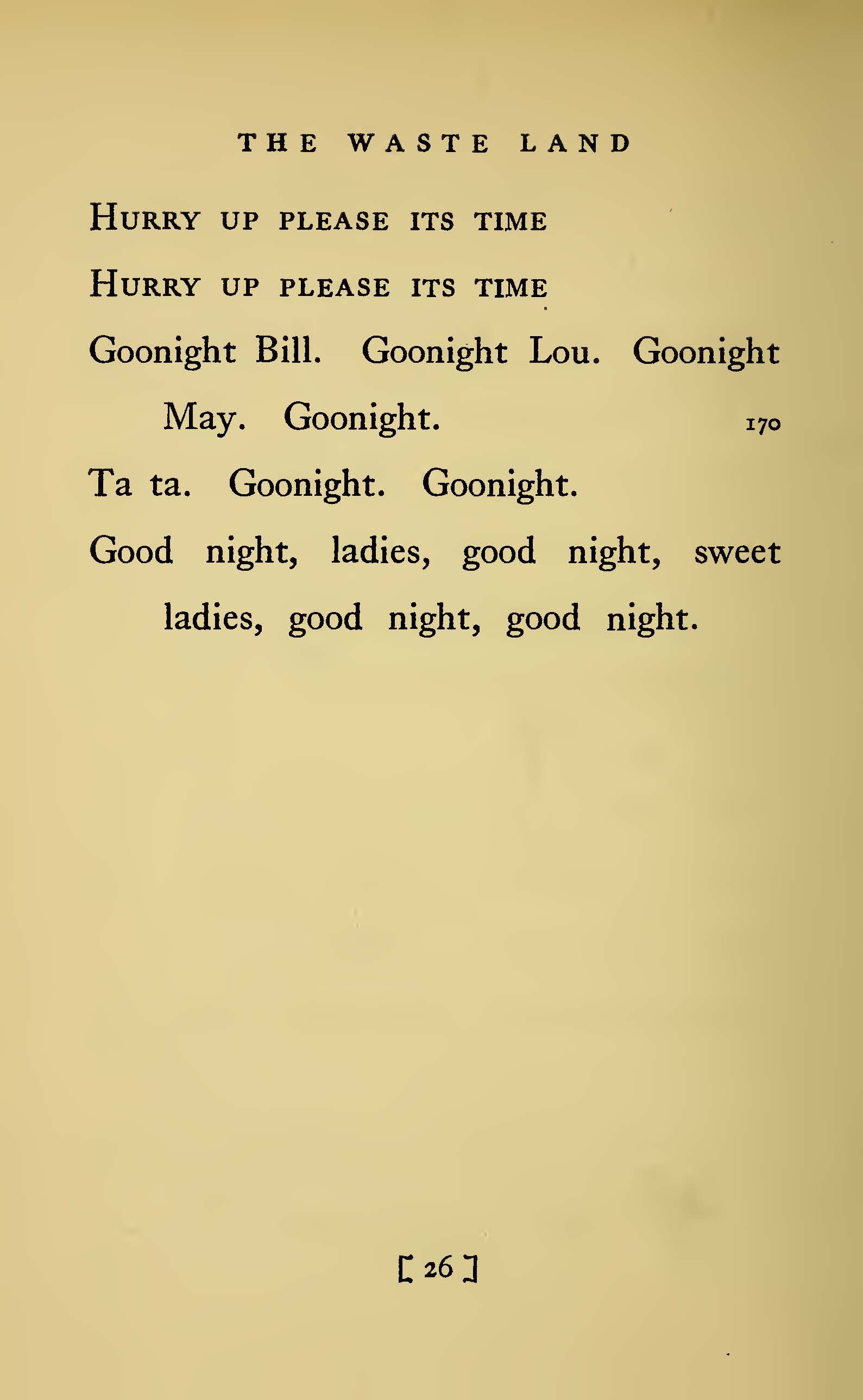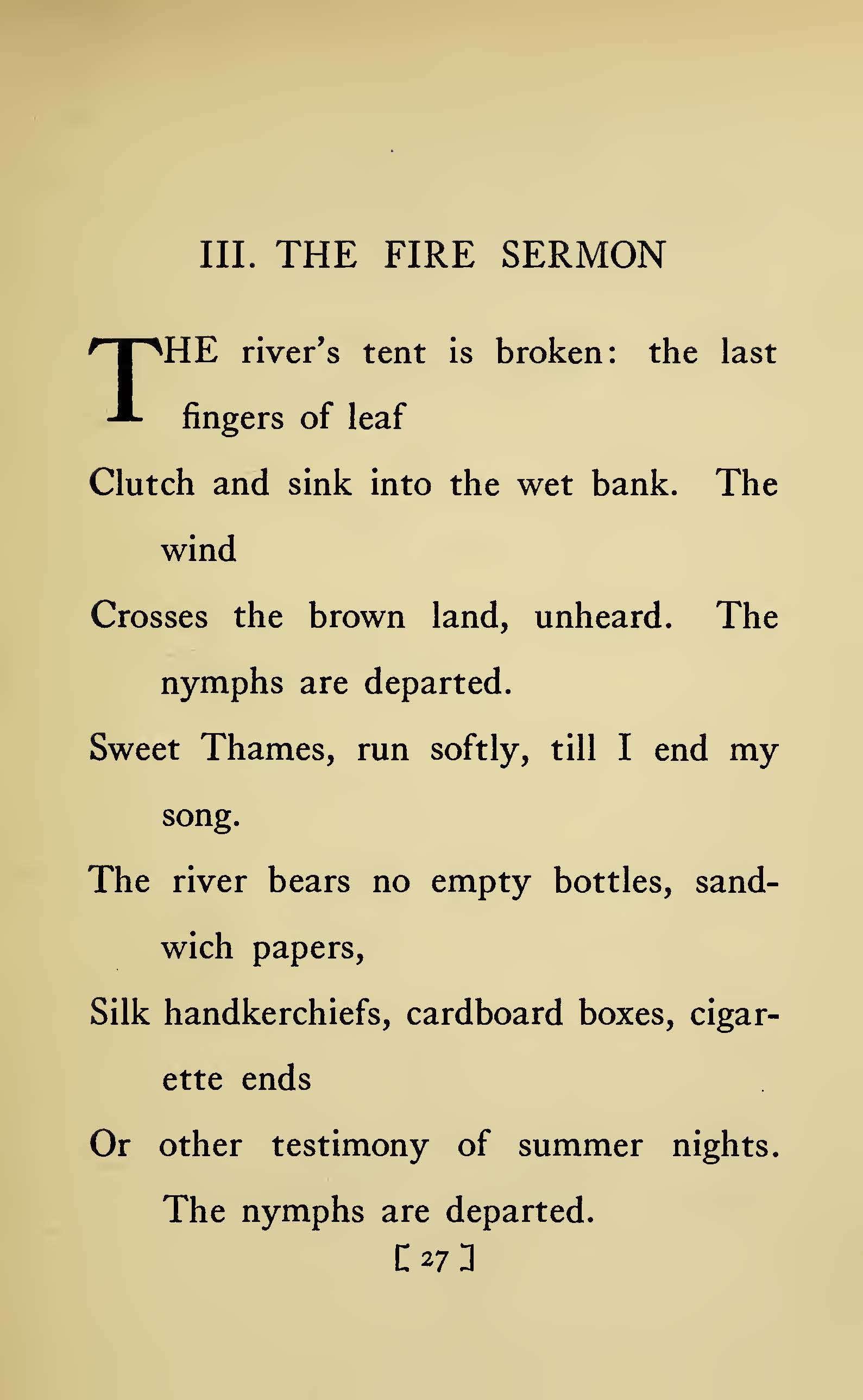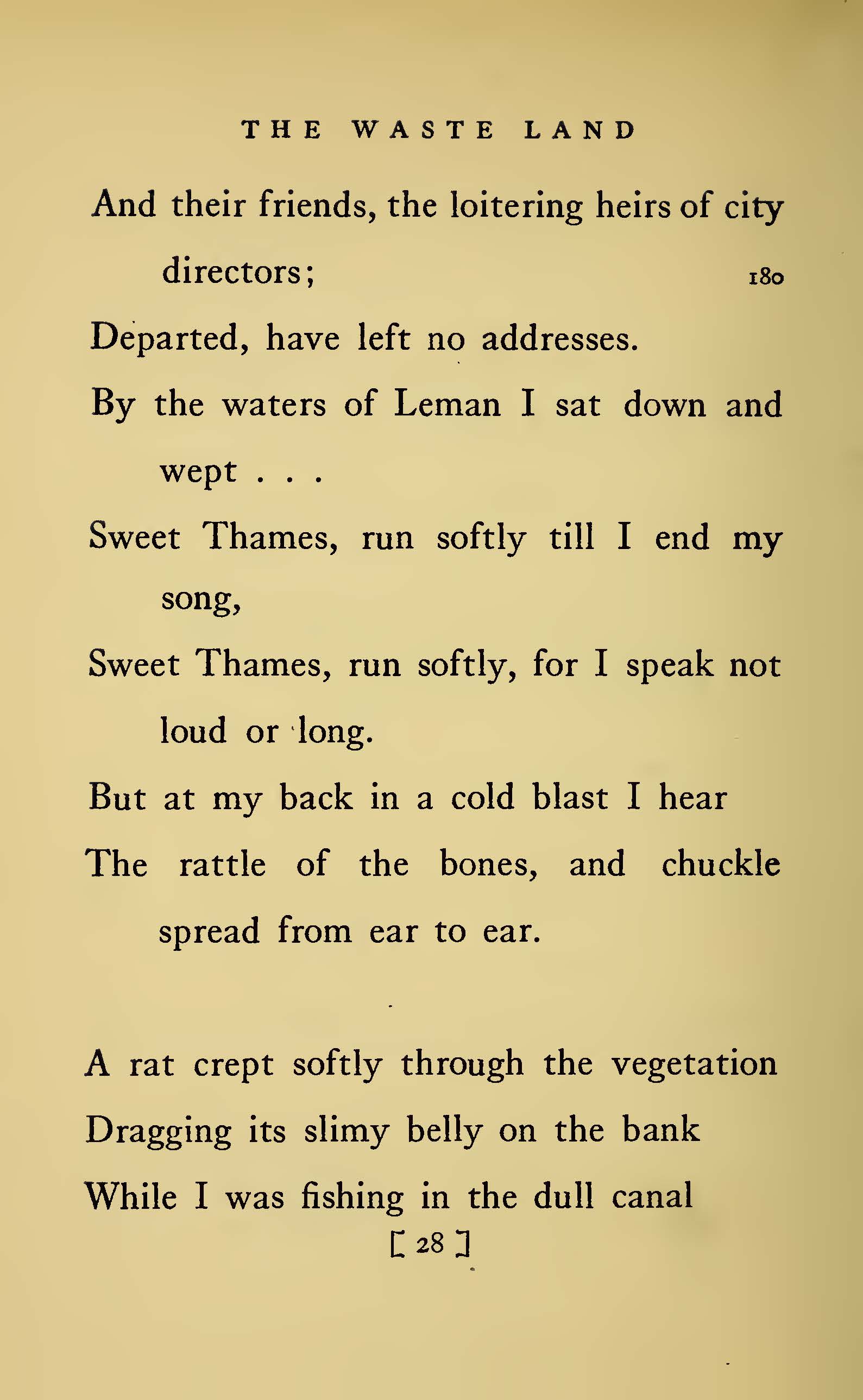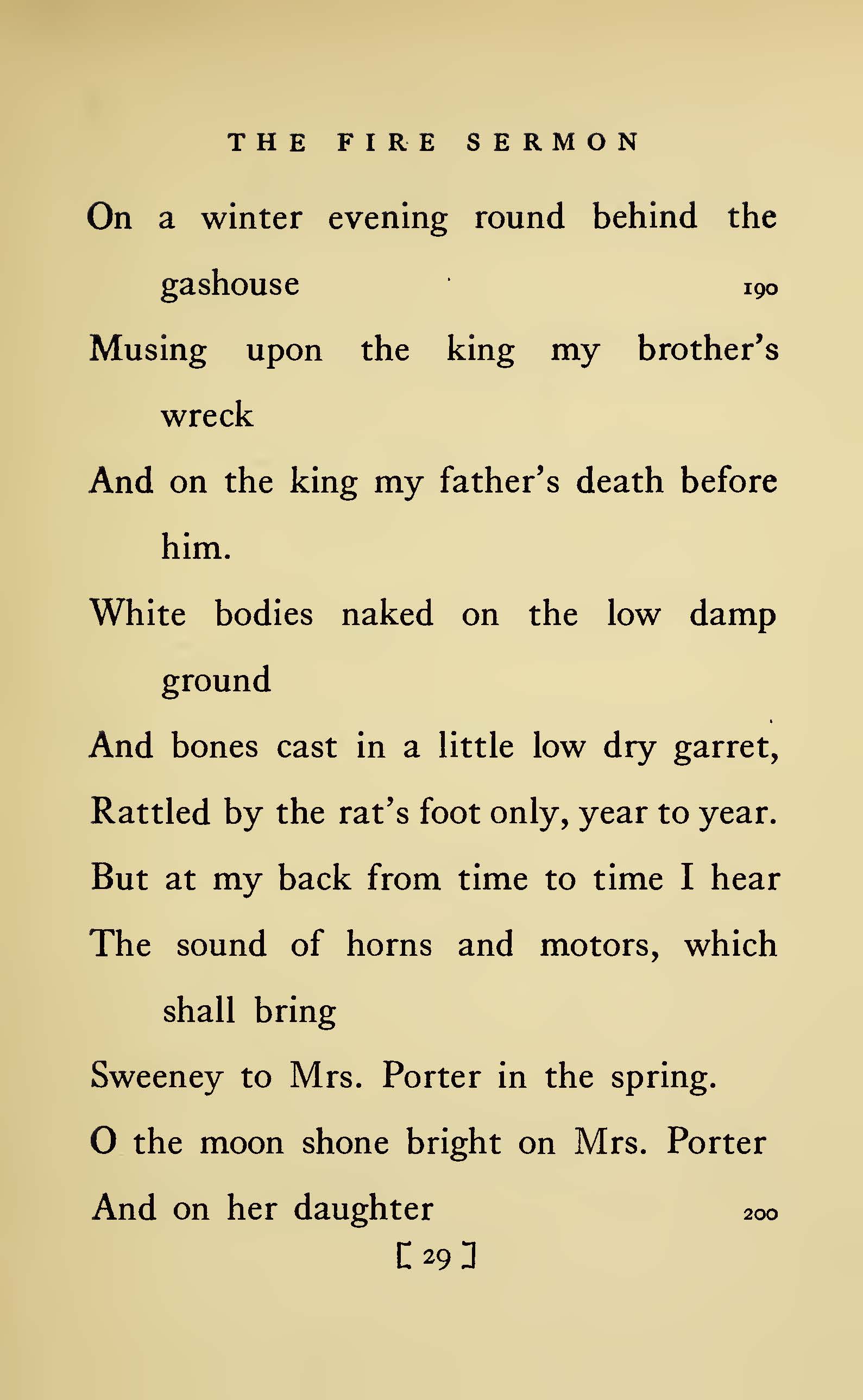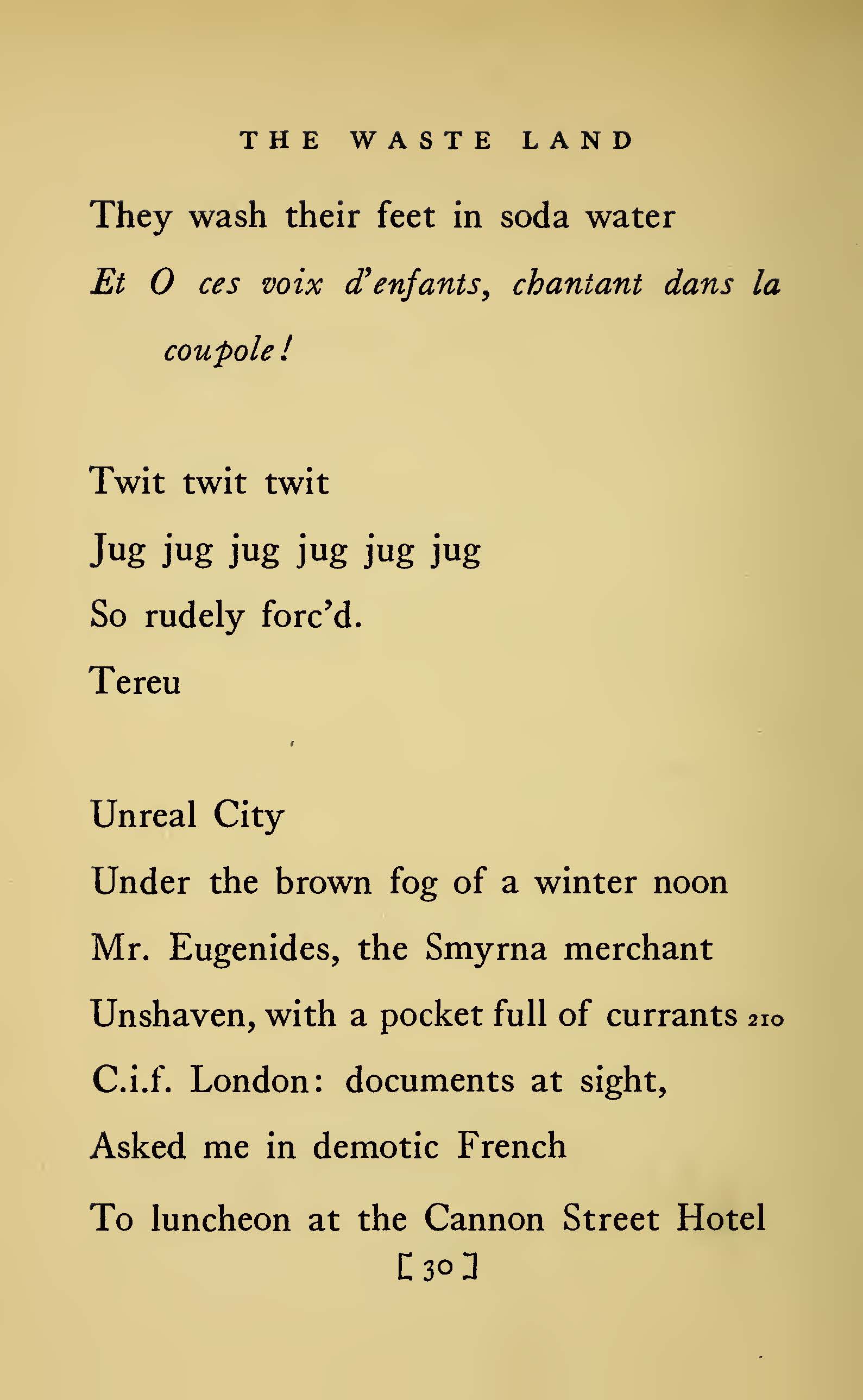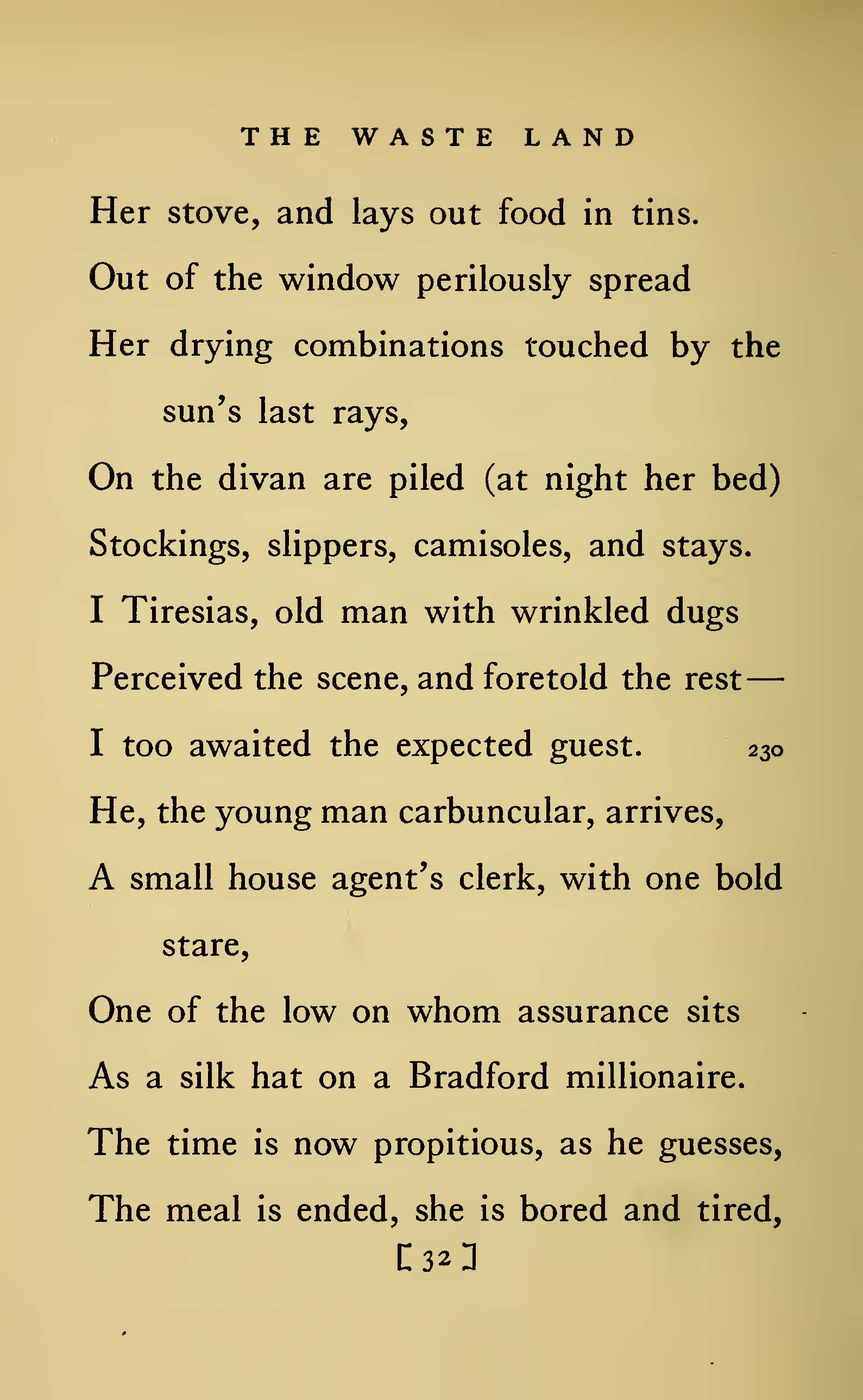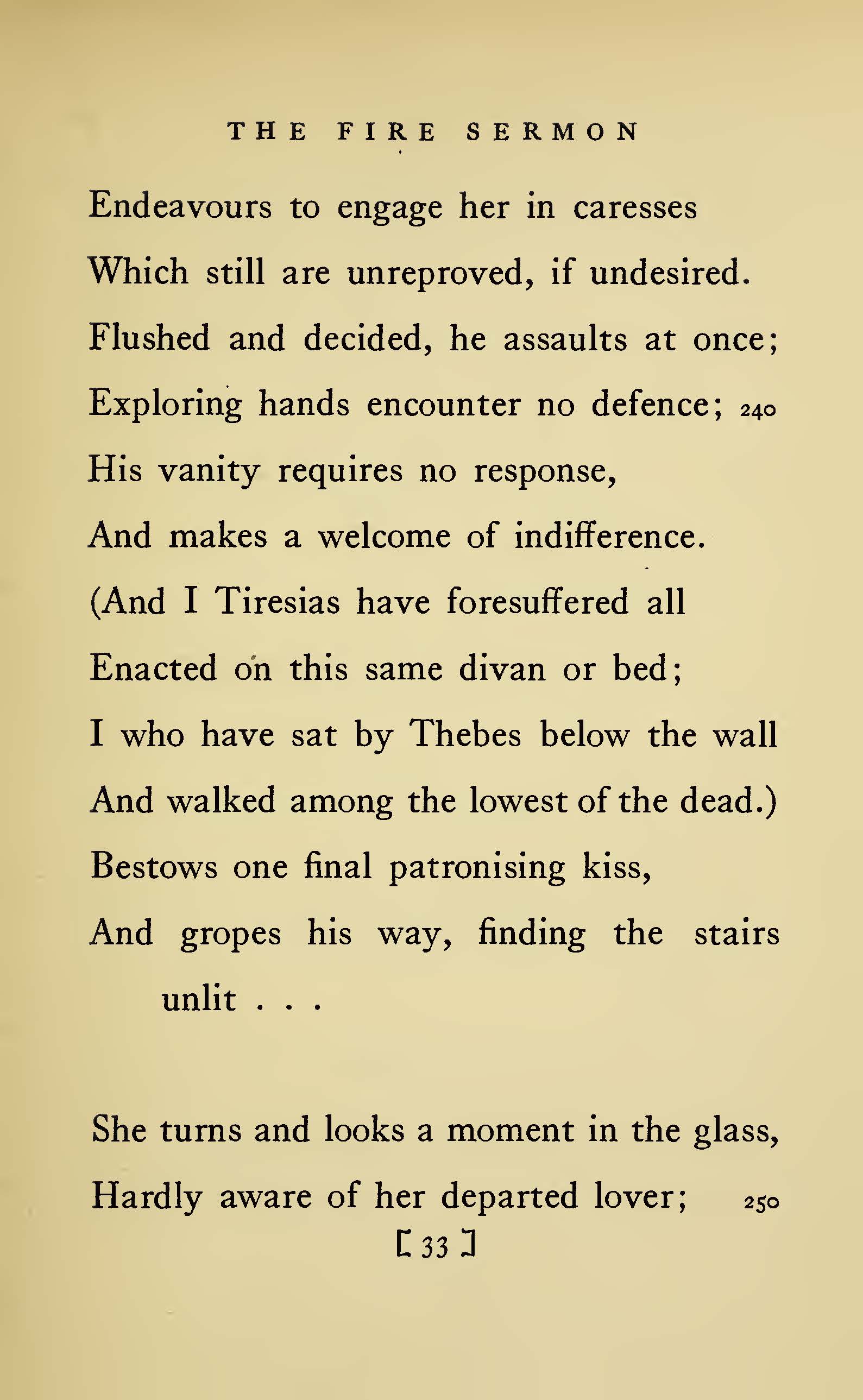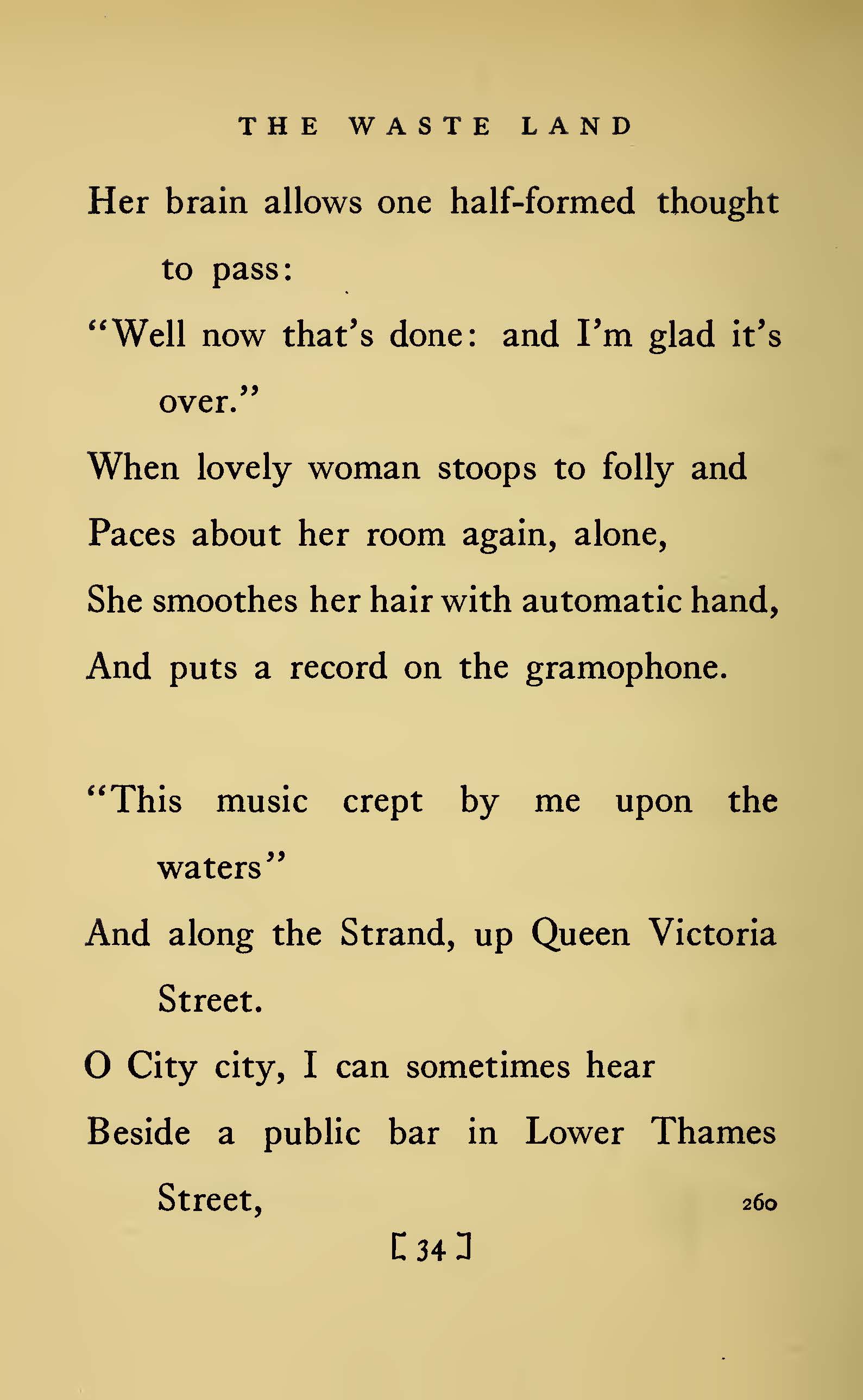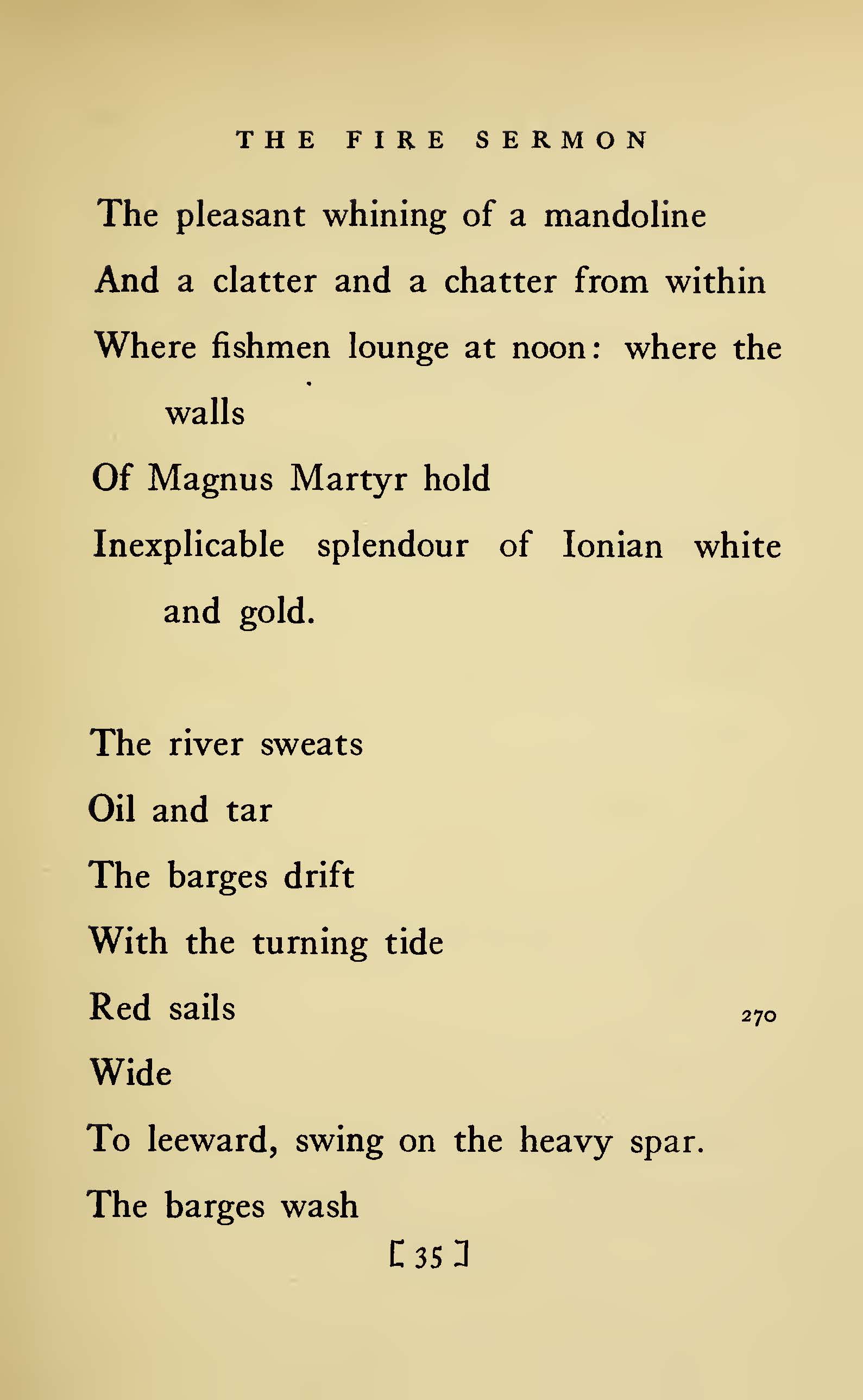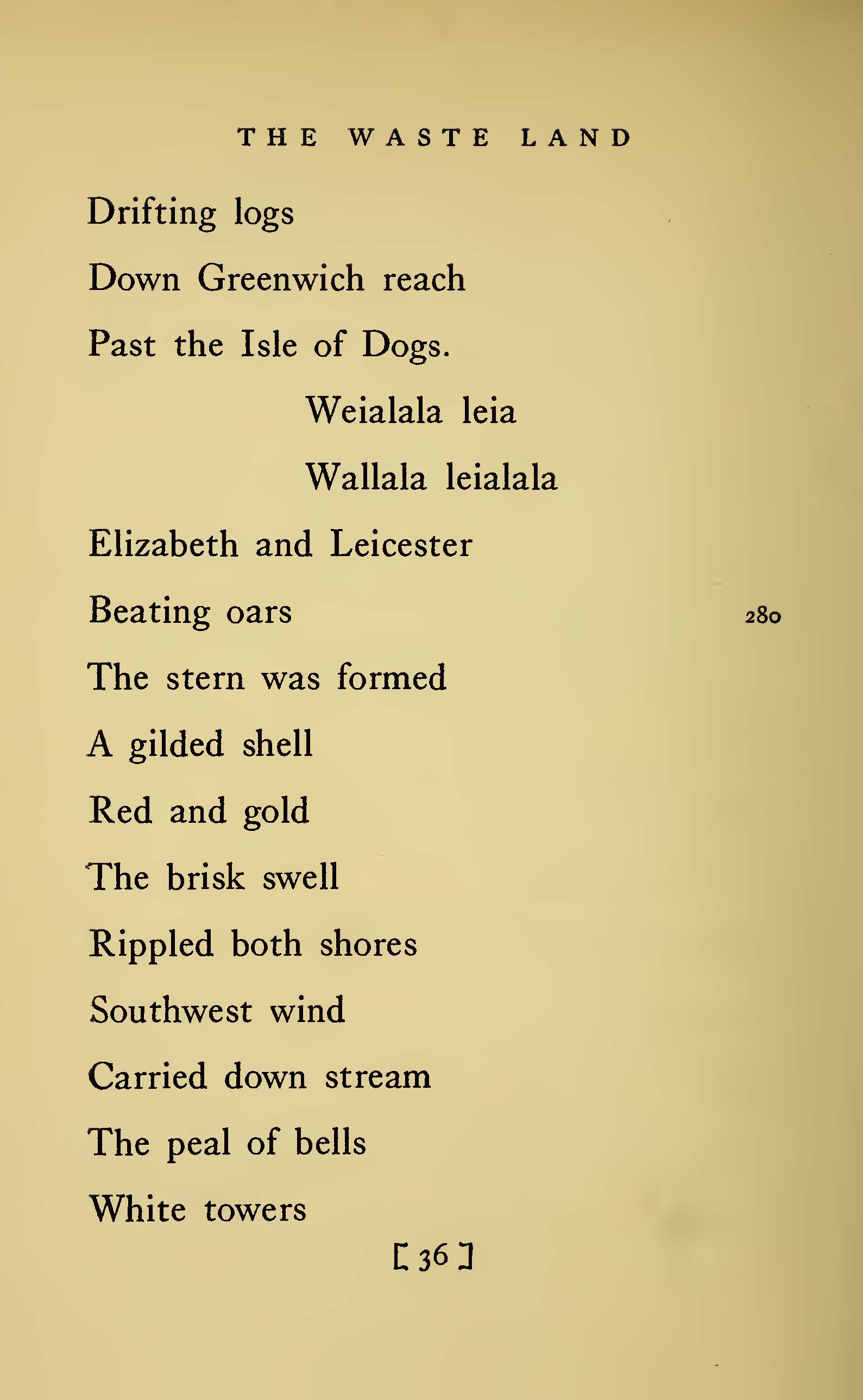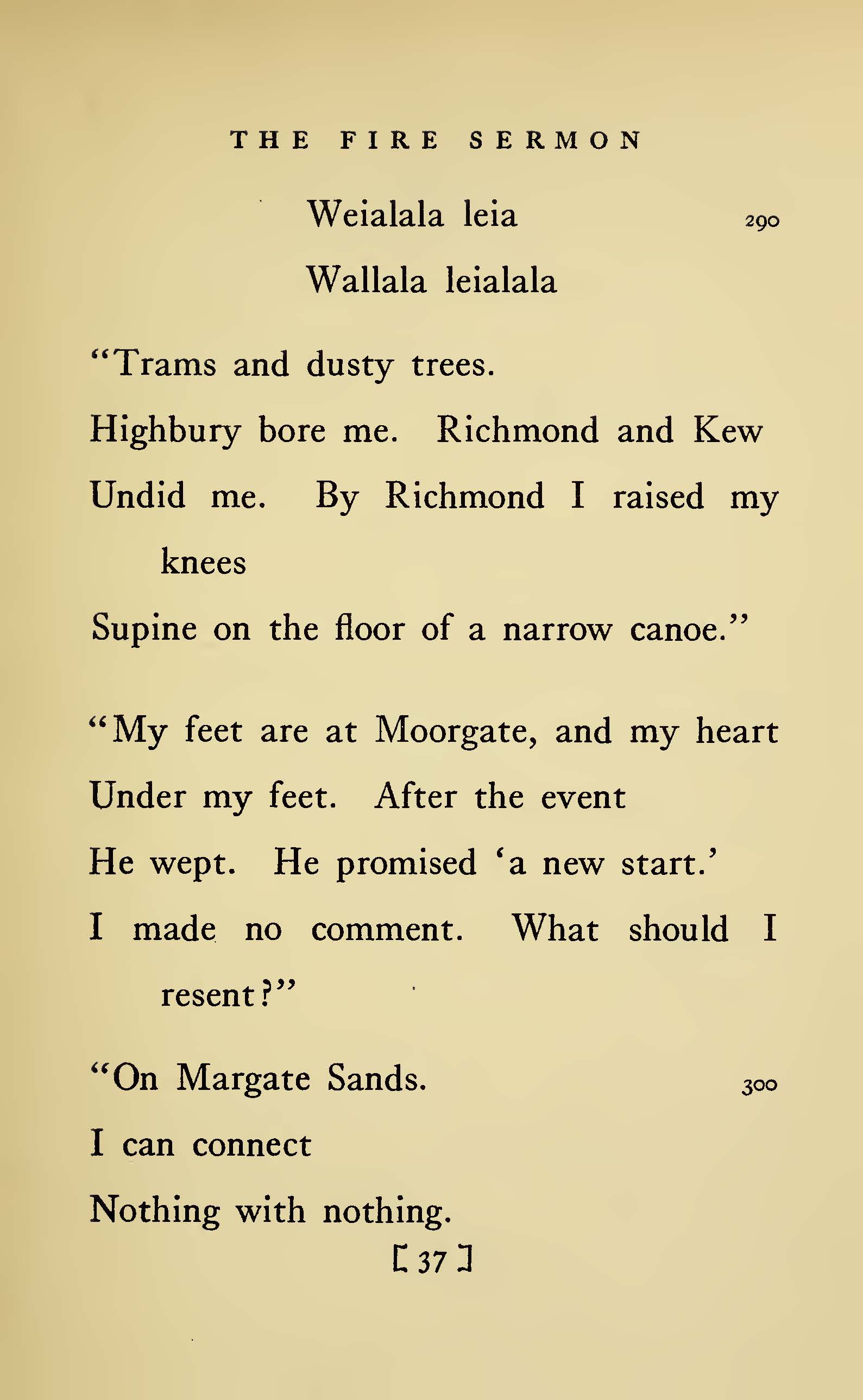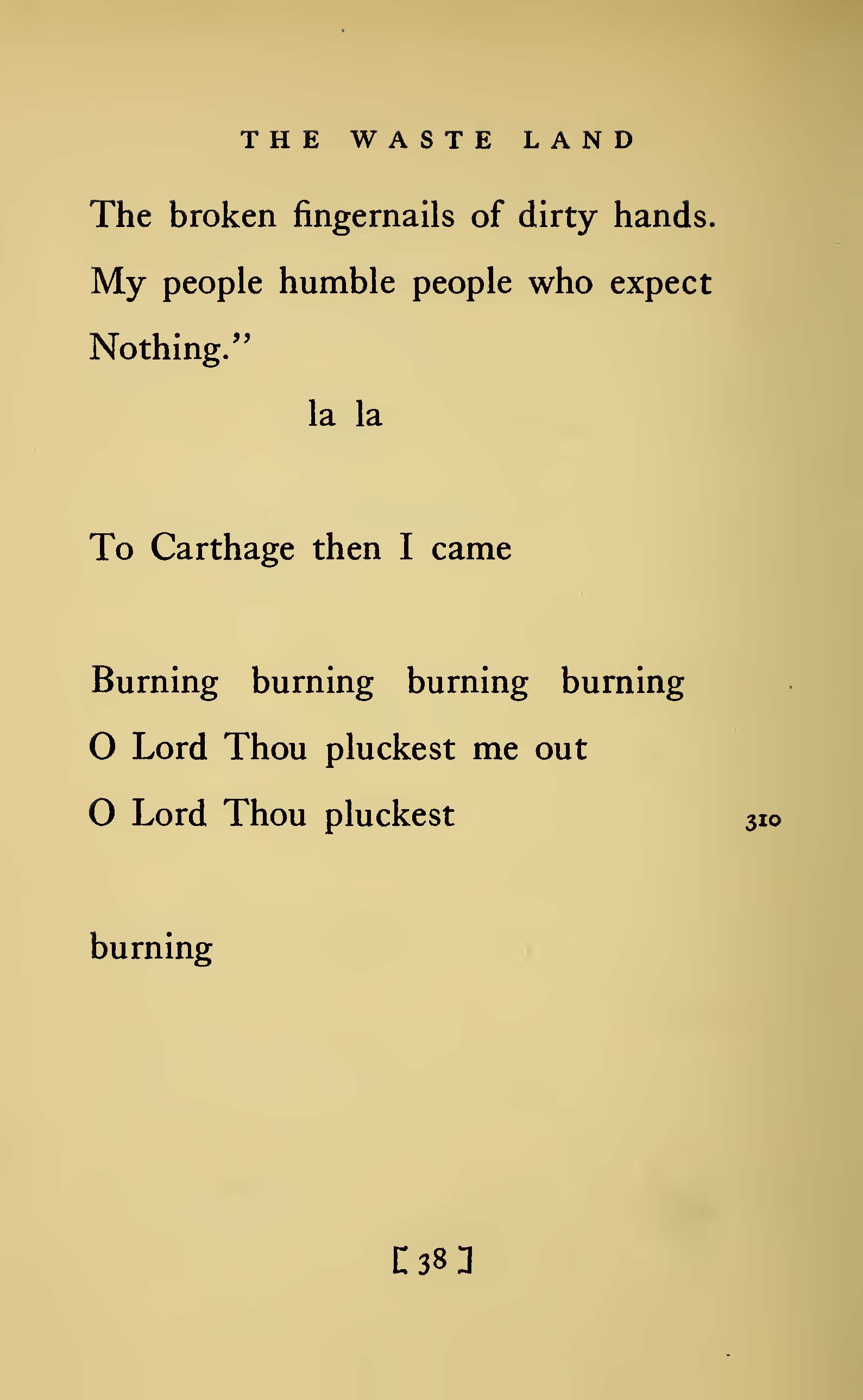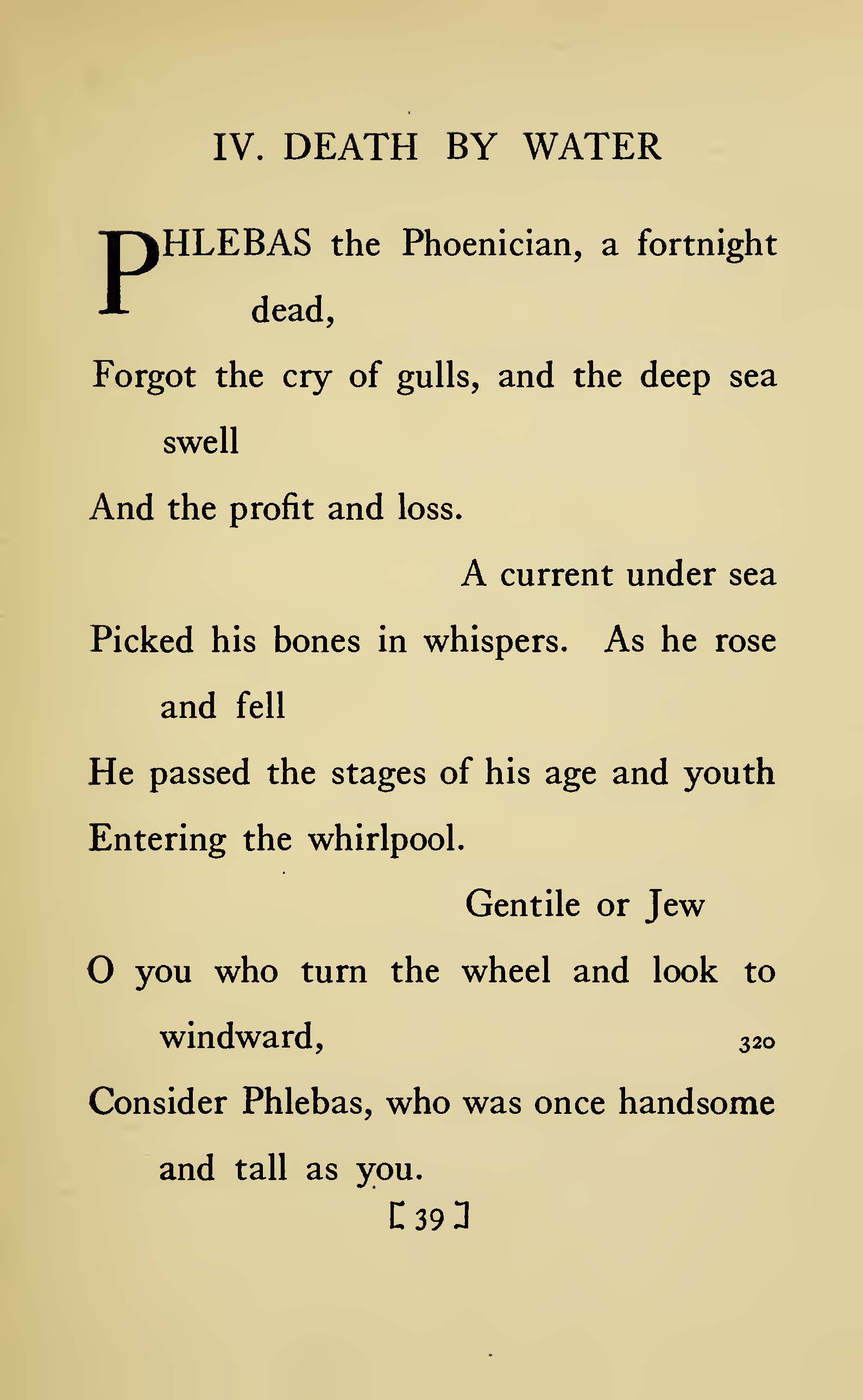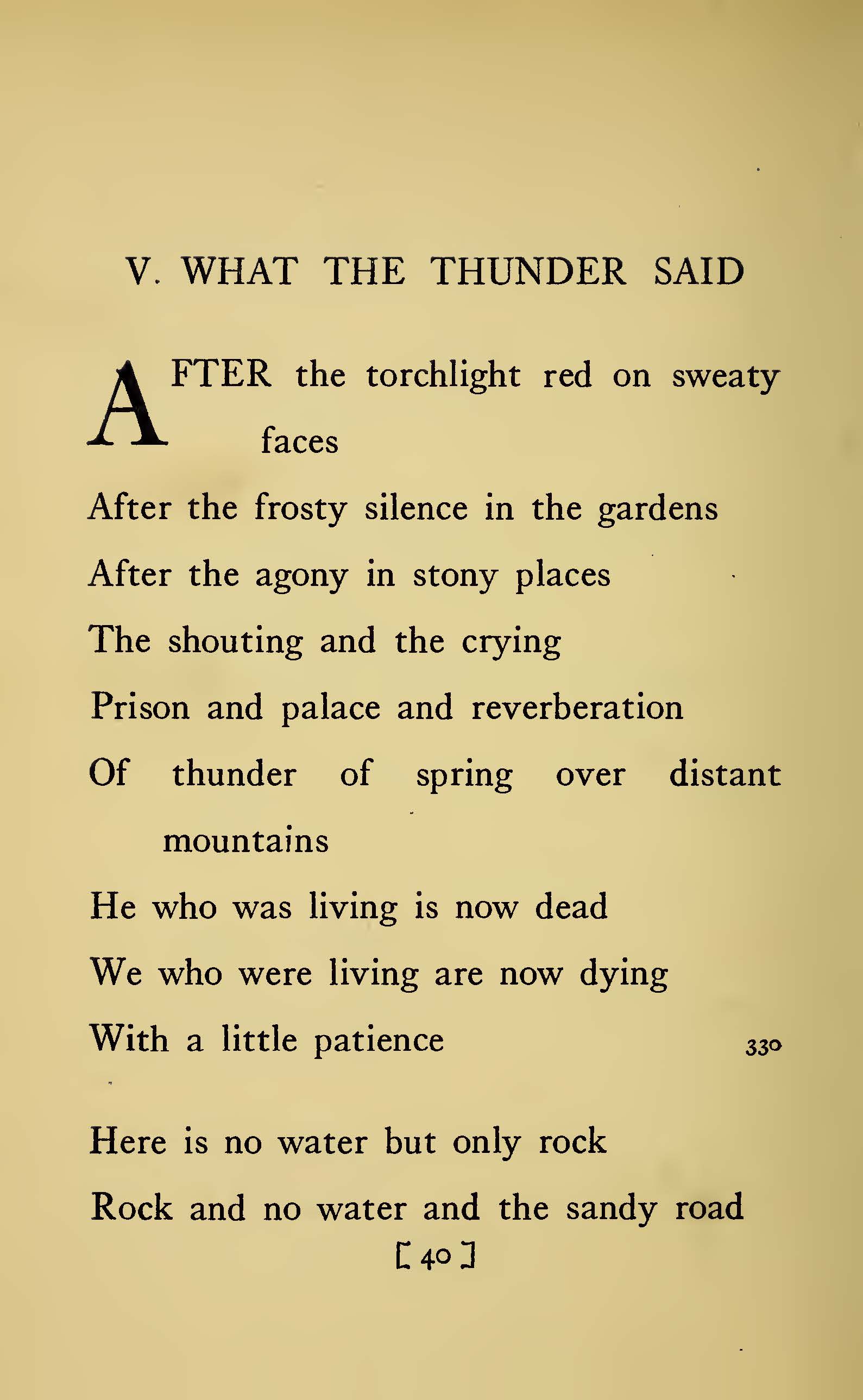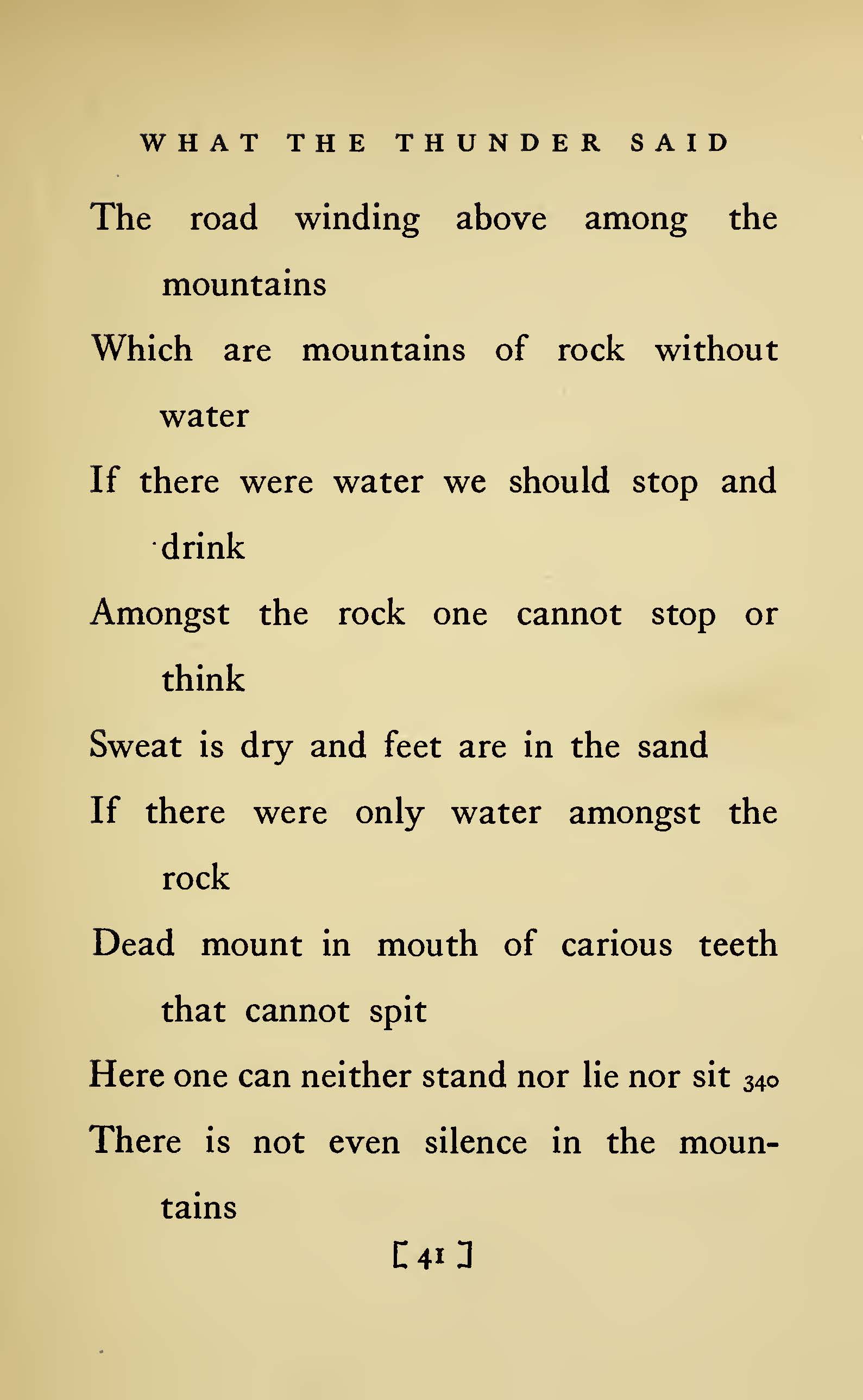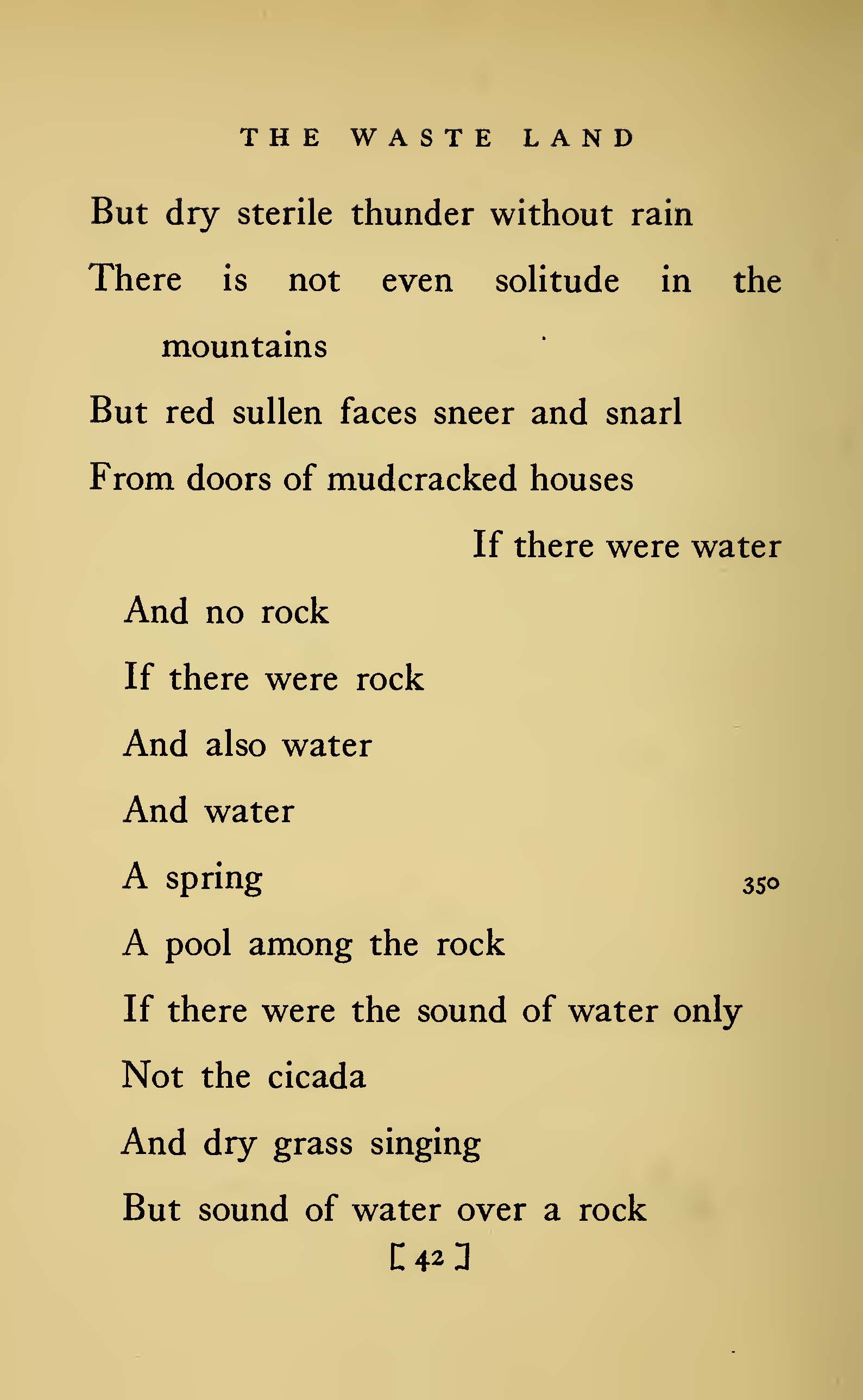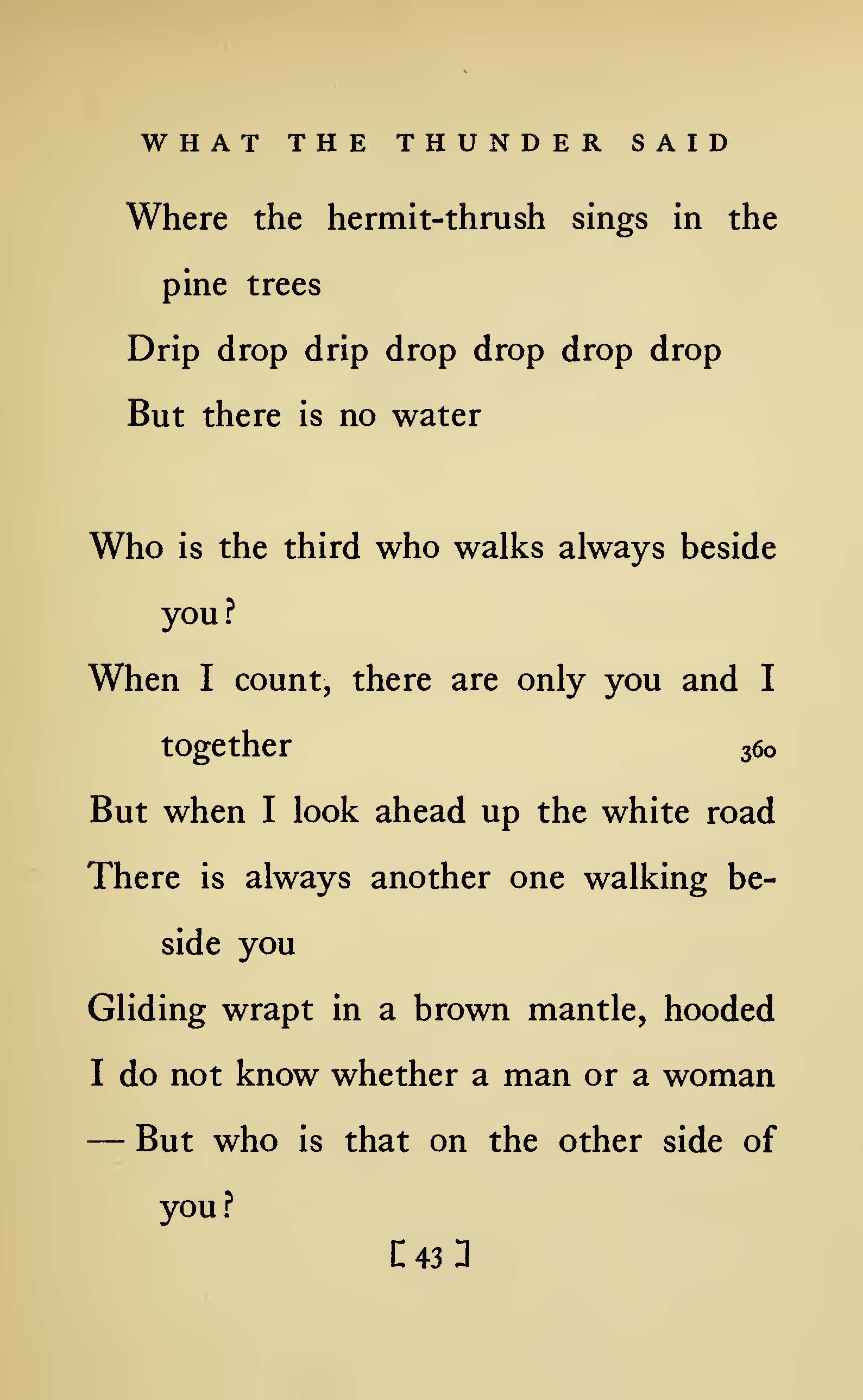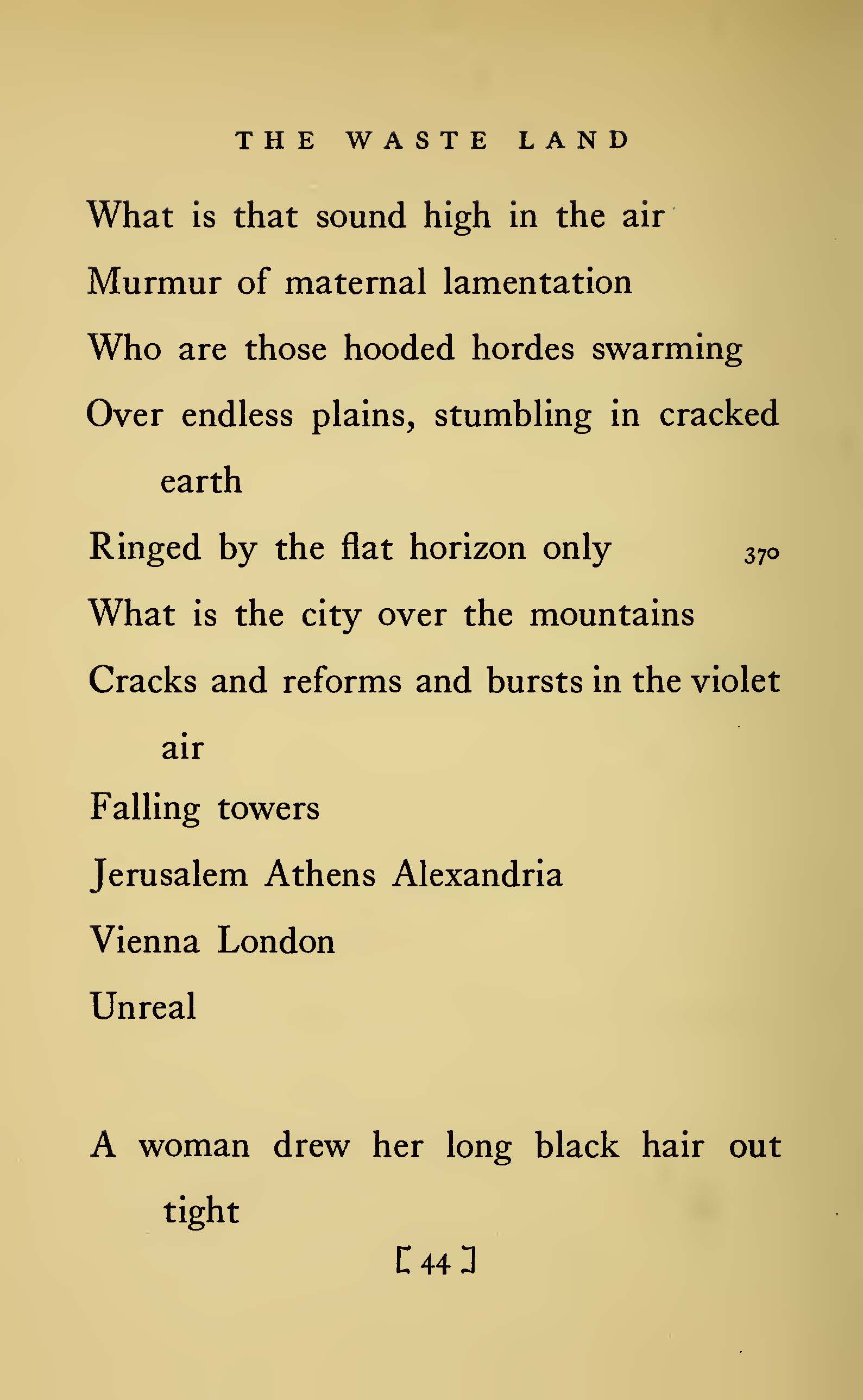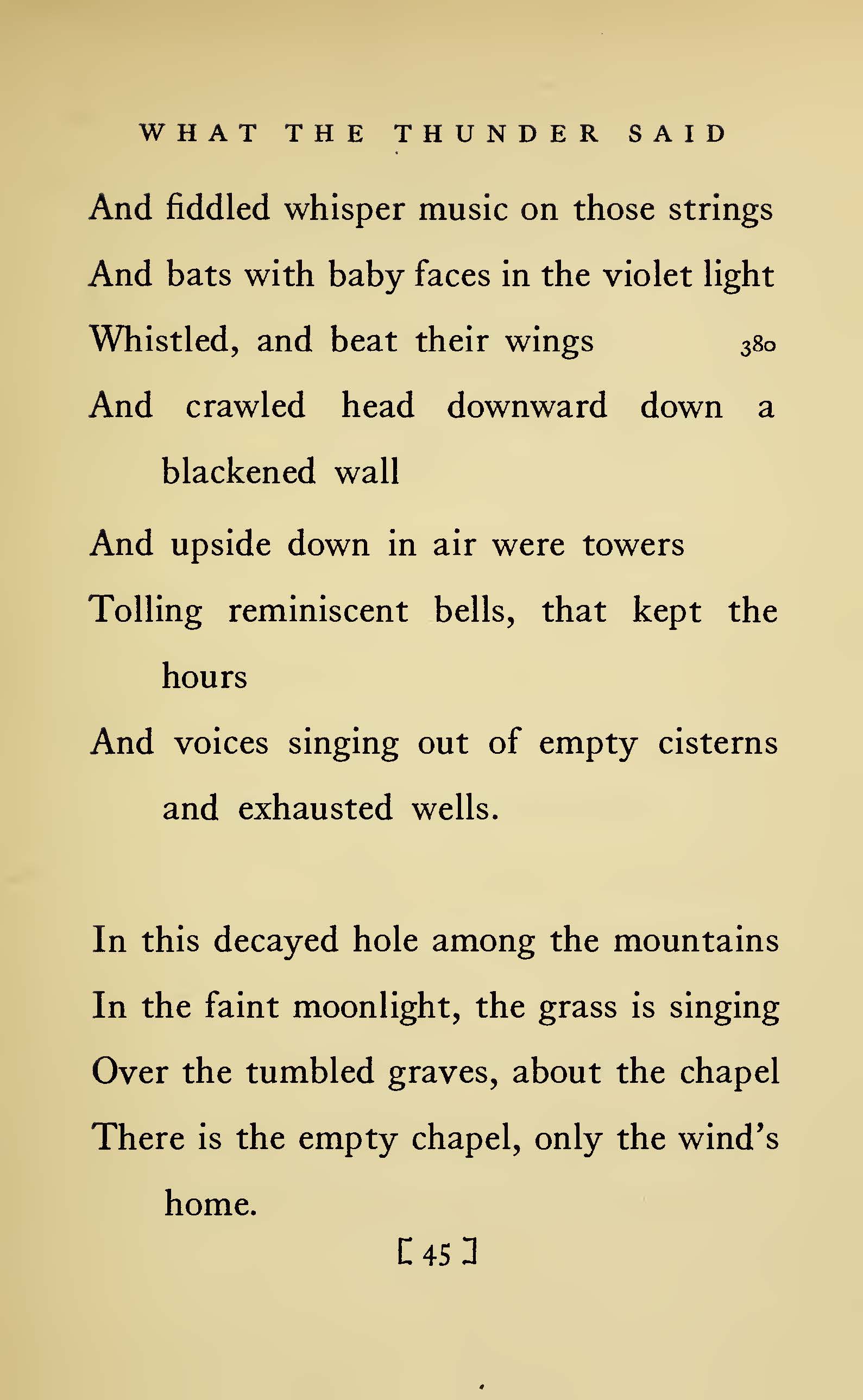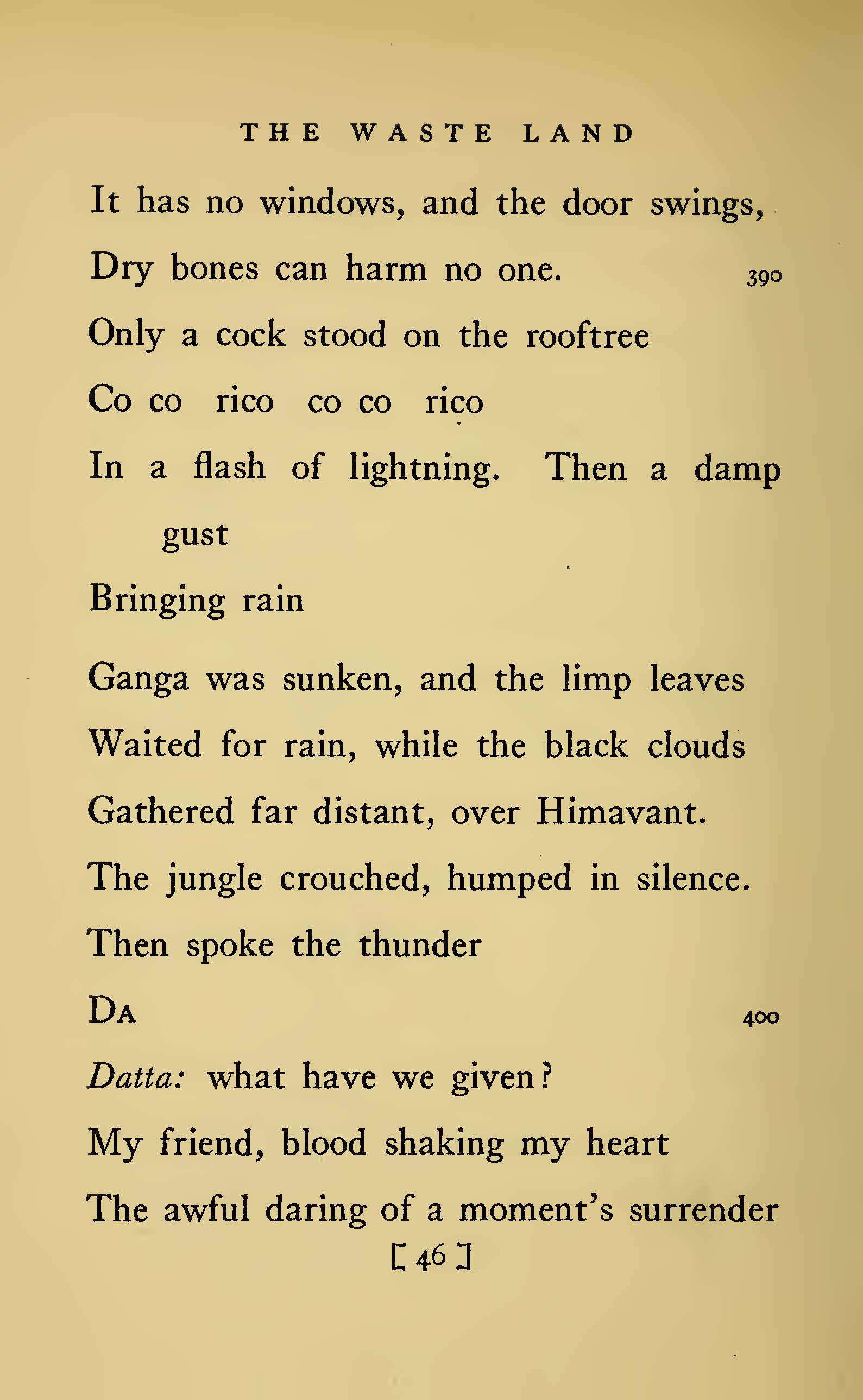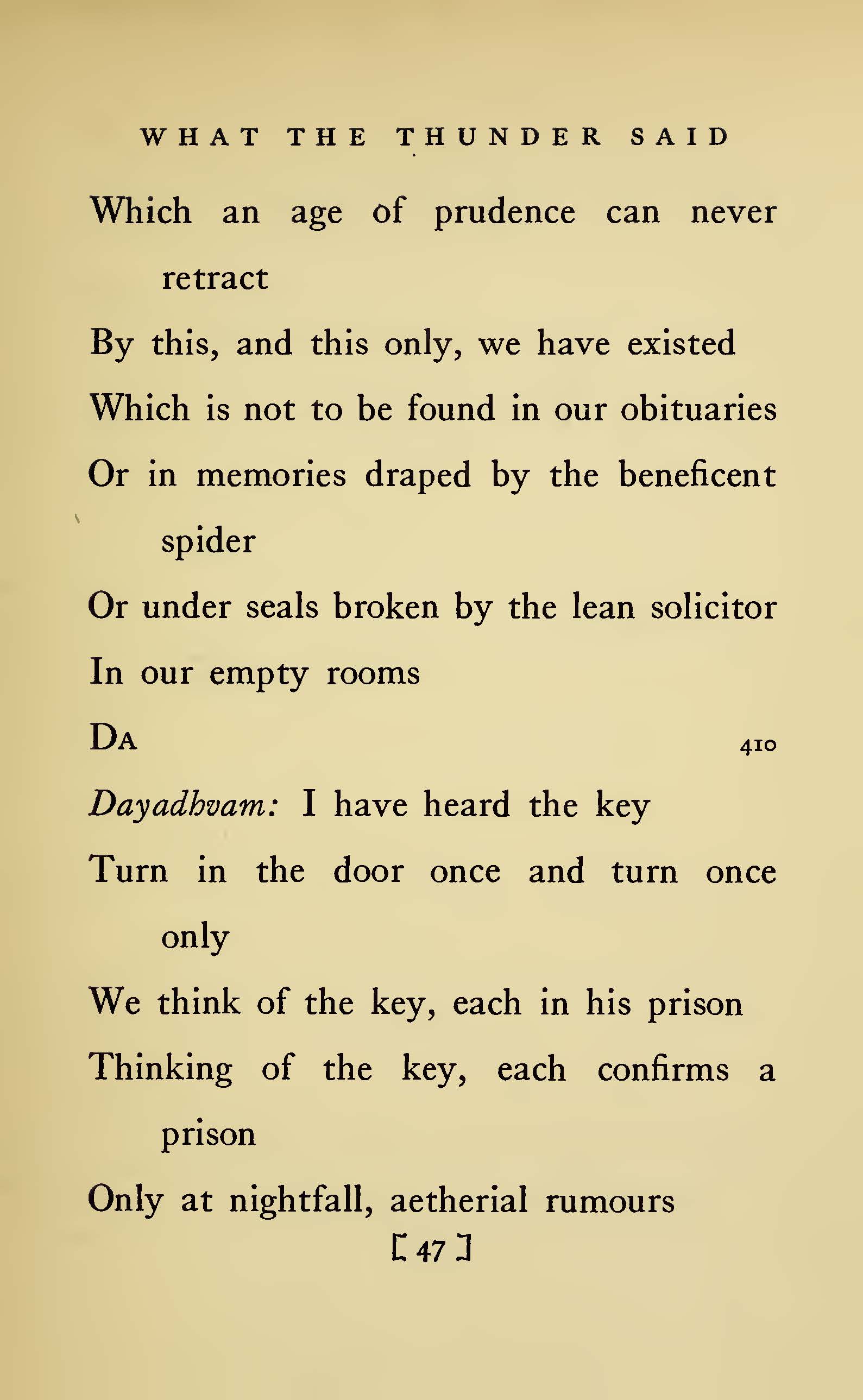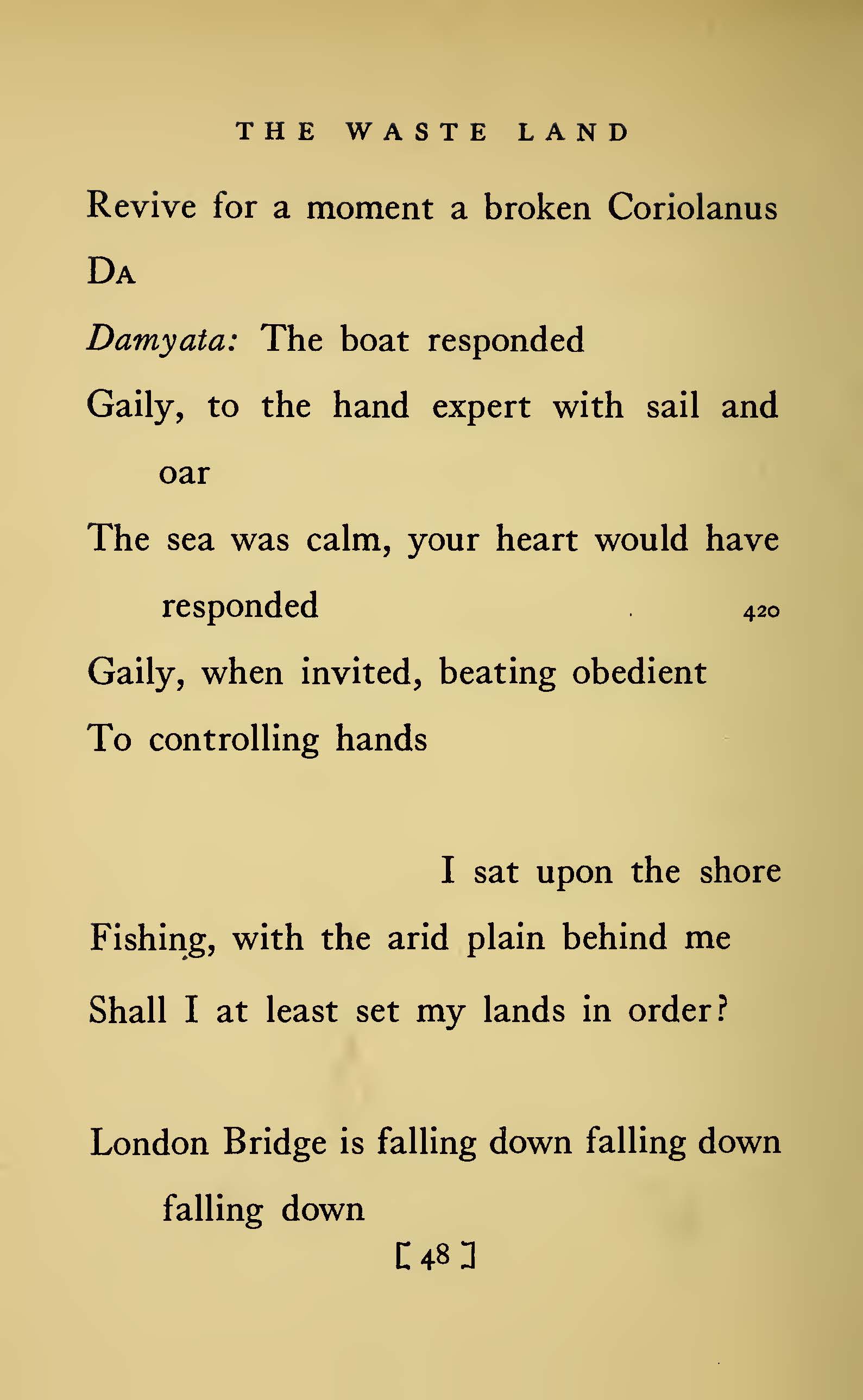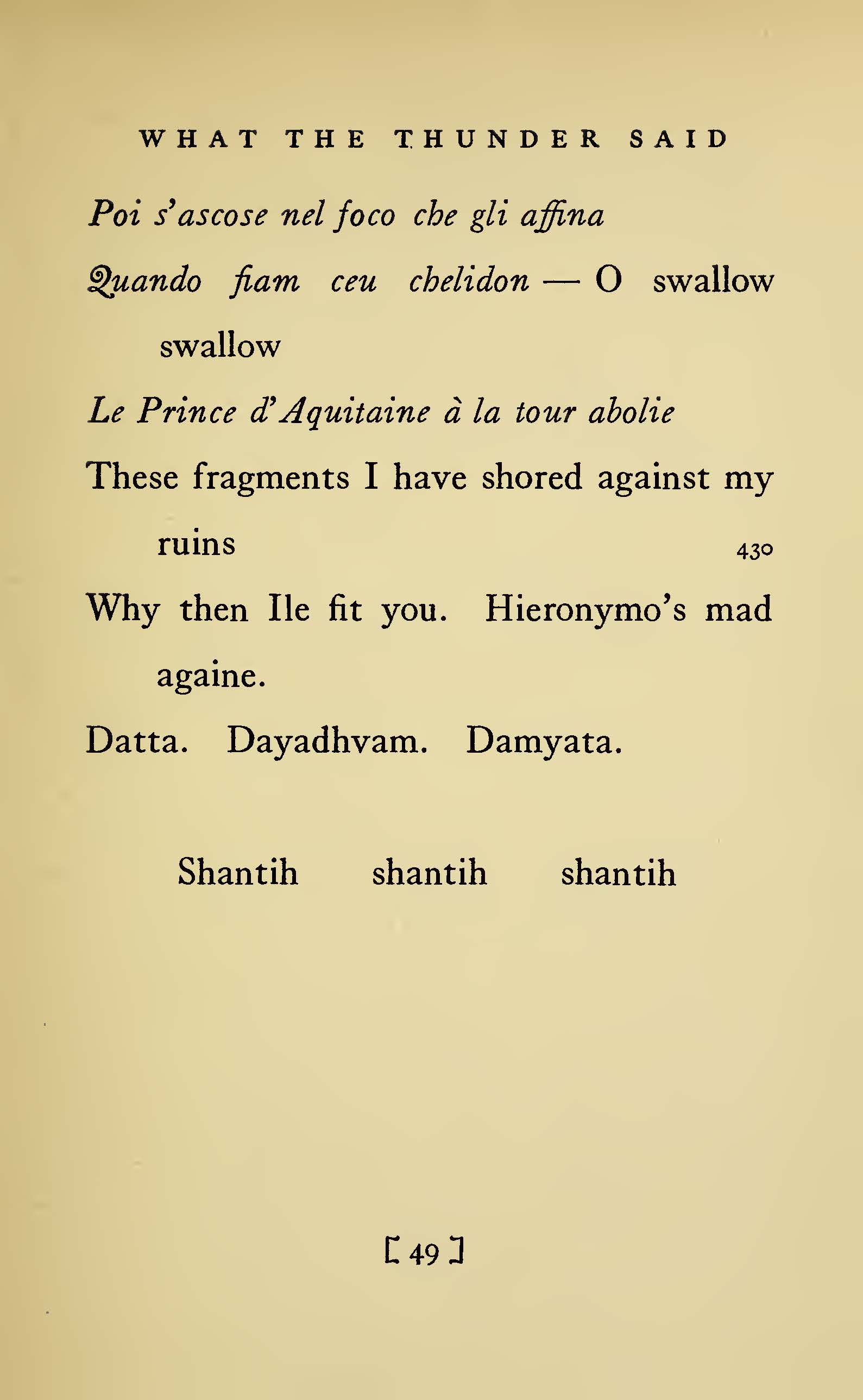The Waste Land
By
T.S. Eliot
Markup by Students and Staff of Marymount University, Greg Gillespie, Tonya Howe, Zafit Olea, Caroline Peloquin
epigraphThis is a quote from the first-century Roman prose work Satyricon (c.54-68) believed to be by Gaius Petronius
(27-66CE). Eliot translated the epigraph as follows: "I saw with my own eyes
the Sibyl at Cumae hanging in a cage, and when the boys said to her: 'Sibyl,
what do you want?' she answered: 'I want to die.'" - [TH]ChaucerThe first line of The Waste Land alludes to the
General Prologue of Geoffrey Chaucer's Canterbury
Tales, which opens with a "description of Spring characteristic of
dream visions of secular love" (Harvard). Chaucer's poem begins, in modern English, as follows:
When April with its sweet-smelling showers
THas pierced the drought of March to the root,
And bathed every vein (of the plants) in such liquid
By which power the flower is created;
When the West Wind also with its sweet breath
In every wood and field has breathed life into
The tender new leaves, and the young sun
Has run half its course in Aries,
And small fowls make melody,
Those that sleep all the night with open eyes
(So Nature incites them in their hearts),
Then folk long to go on pilgrimages,
And professional pilgrims to seek foreign shores,
To distant shrines, known in various lands.... (General
Prologue, 1-14)
You might consider how Eliot's version compares to
this source text. - [TH]identity
In this passage, the female speaker's statement, "I am not Russian at all; I
come from Lithuania, really German," introduces the theme of fragmentation
and displacement that permeates the poem. The speaker's identity is shaped
by multiple cultural influences, resulting in a fragmented sense of self.
She does not fully identify as Russian, Lithuanian, or German, but as a
hybrid of all three. This complex identity further highlights the themes of
displacement and cultural conflict throughout the work.
- [ZO]Wagner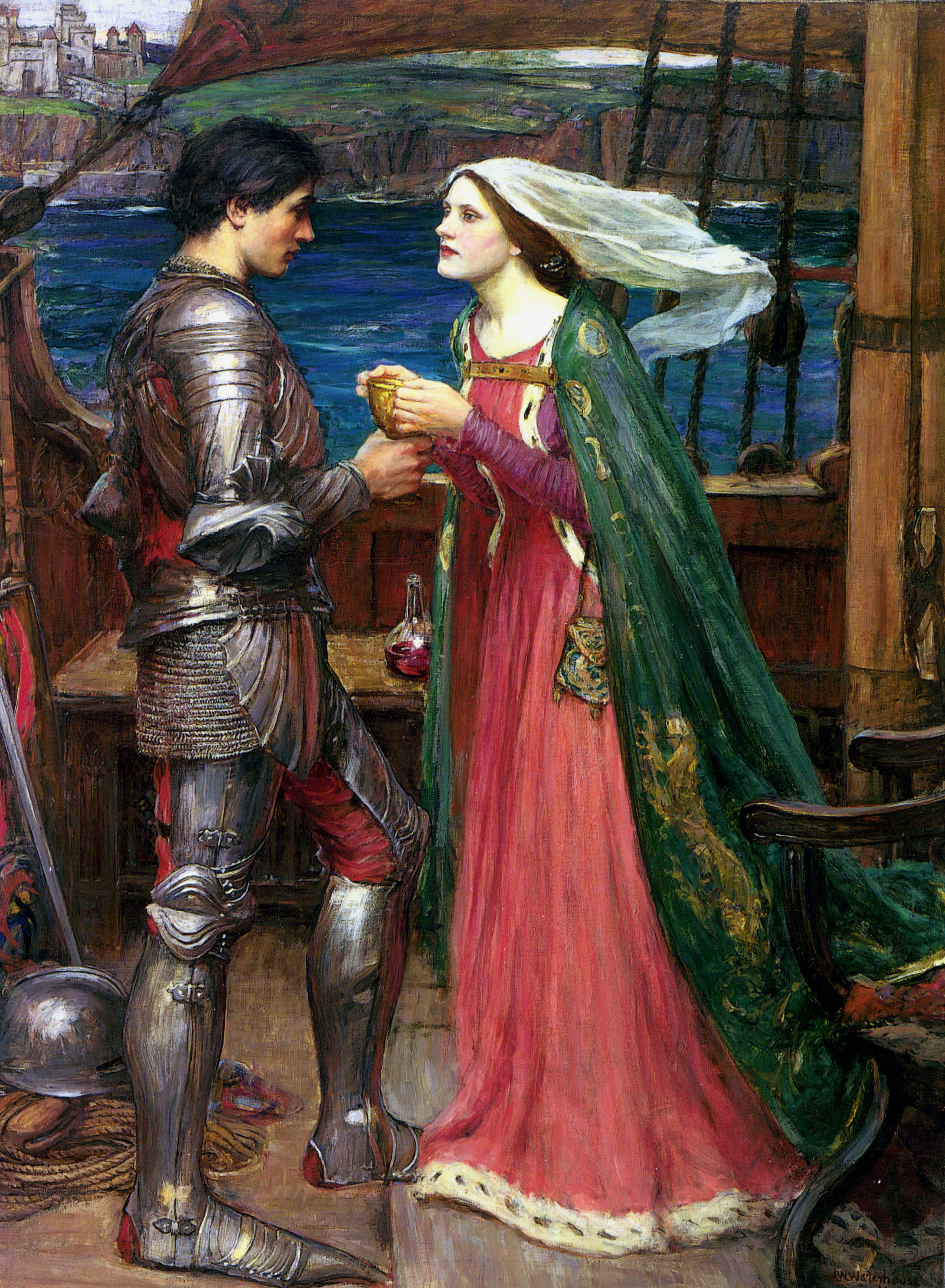 These lines are quoted from Richard Wagner's Tristan und
Isolde (1865), a German opera based on a 12th century chivalric tragic
poem Tristan and Iseult. There are multiple different
versions of the story, but at root, it is a Celtic legend about tragic love; the
knight Tristan has been tasked with accompanying the Irish maiden Iseult to be
married to his uncle, the King of Cornwall. On the way, Tristan and Iseult fall
deeply in love, which causes many tempestuous problems. The story became very
popular in the ninteenth and early twentieth centuries, especially among the
Pre-Raphaelites, a group of artists and writers influenced by Romanticism who
sought inspiration in Italian Renaissance art and medieval courtly themes. The
image included here, by the Pre-Raphaelite painter John William Waterhouse, is Tristan and Isolde with the Potion (1916), via Wikimedia Commons. Tristan and Iseult are on the ship heading for
Cornwall and Iseult's marriage; they are drinking a love potion. The lines are
from the first act of Tristan und Isolde, and are sung by
an anonymous sailor about his lover, left behind in Ireland. Translated, the lines
read "Fresh blows the wind / homeward: / my Irish maid, / where do you linger?" A
later line (42, below) from the same opera, "Empty and desolate is the sea,"
sandwiches Eliot's description of the first meeting between the "hyacinth girl"
(36) and her lover, who remembers being struck by her and feeling "neither /
Living nor dead" (39-40). ( - [TH]clairvoyant
This noun comes from the word "clairvoyance", which in the French means
clear-sighted. A clairvoyant is what we would now call a psychic, someone
who can see things that are not physically there. Madame Sosostris is a
fortune teller who has a reputation as "the wisest woman in Europe." The -e
is added to the word clairvoyant to make it feminine in the French (OED).
- [CP]cardsA character in Eliot's poem visits a famous fortune
teller, and the following lines describe the tarot cards she received at a
reading. According to Elizabeth DeBold of the Folger Shakespeare Library, tarot originated in 14th-century
Egypt, and traveled to Europe during the Renaissance. - [TH]water
Water is a prevalent motif throughout The Waste
Land. Water is often associated with regeneration/rebirth, but here and
elsewhere, it is associated with death.
- [CP]woolnoth
These lines are quoted from Richard Wagner's Tristan und
Isolde (1865), a German opera based on a 12th century chivalric tragic
poem Tristan and Iseult. There are multiple different
versions of the story, but at root, it is a Celtic legend about tragic love; the
knight Tristan has been tasked with accompanying the Irish maiden Iseult to be
married to his uncle, the King of Cornwall. On the way, Tristan and Iseult fall
deeply in love, which causes many tempestuous problems. The story became very
popular in the ninteenth and early twentieth centuries, especially among the
Pre-Raphaelites, a group of artists and writers influenced by Romanticism who
sought inspiration in Italian Renaissance art and medieval courtly themes. The
image included here, by the Pre-Raphaelite painter John William Waterhouse, is Tristan and Isolde with the Potion (1916), via Wikimedia Commons. Tristan and Iseult are on the ship heading for
Cornwall and Iseult's marriage; they are drinking a love potion. The lines are
from the first act of Tristan und Isolde, and are sung by
an anonymous sailor about his lover, left behind in Ireland. Translated, the lines
read "Fresh blows the wind / homeward: / my Irish maid, / where do you linger?" A
later line (42, below) from the same opera, "Empty and desolate is the sea,"
sandwiches Eliot's description of the first meeting between the "hyacinth girl"
(36) and her lover, who remembers being struck by her and feeling "neither /
Living nor dead" (39-40). ( - [TH]clairvoyant
This noun comes from the word "clairvoyance", which in the French means
clear-sighted. A clairvoyant is what we would now call a psychic, someone
who can see things that are not physically there. Madame Sosostris is a
fortune teller who has a reputation as "the wisest woman in Europe." The -e
is added to the word clairvoyant to make it feminine in the French (OED).
- [CP]cardsA character in Eliot's poem visits a famous fortune
teller, and the following lines describe the tarot cards she received at a
reading. According to Elizabeth DeBold of the Folger Shakespeare Library, tarot originated in 14th-century
Egypt, and traveled to Europe during the Renaissance. - [TH]water
Water is a prevalent motif throughout The Waste
Land. Water is often associated with regeneration/rebirth, but here and
elsewhere, it is associated with death.
- [CP]woolnoth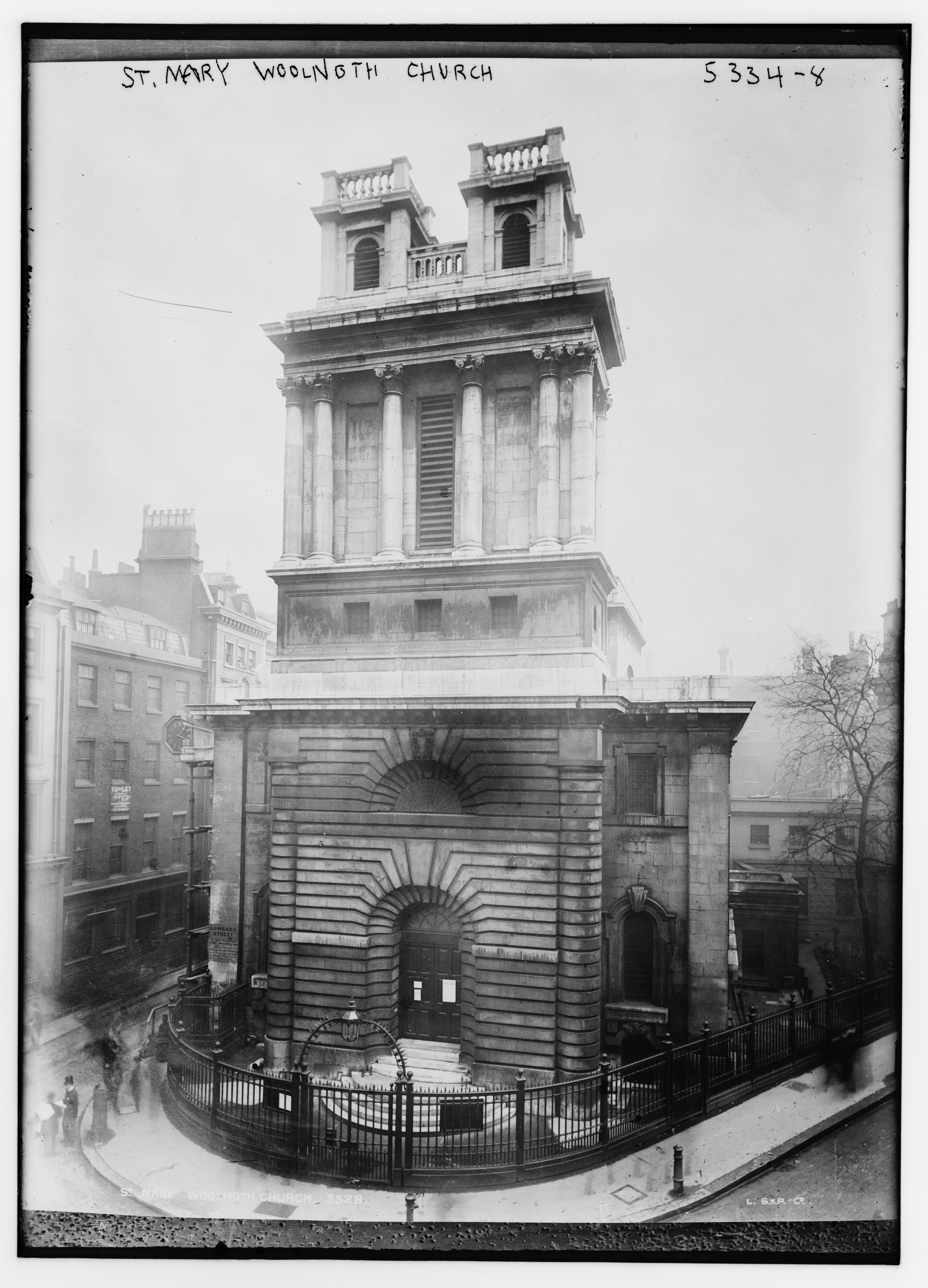 Saint Mary
Woolnoth is an Anglican church in London, first built in the 12th century,
then rebuilt on several occasions. The photograph included here, from about
1900, originally from the Library of Congress, shows the church in its
modern form, designed by Nicholas Hawksmoore and opened in 1727. This is
likely very close to what Eliot would have seen. It is possible that the
site had been a place of worship for 2000 years (Wikipedia).
- [TH]mylaeThe Battle of
Mylae, a naval battle won in 260BCE by Roman naval
forces. - [TH]baudelaireThis is an allusion to the last line of Charles
Baudelaire's introductory poem "Au Lecteur [To the Reader]" from his
collection Fleurs du mal [Flowers of Evil
(1857-1868). The line reads, "Hypocritical reader, --my twin, --my
brother!" You can read Baudelaire's poems online. - [TH]cupidon
Saint Mary
Woolnoth is an Anglican church in London, first built in the 12th century,
then rebuilt on several occasions. The photograph included here, from about
1900, originally from the Library of Congress, shows the church in its
modern form, designed by Nicholas Hawksmoore and opened in 1727. This is
likely very close to what Eliot would have seen. It is possible that the
site had been a place of worship for 2000 years (Wikipedia).
- [TH]mylaeThe Battle of
Mylae, a naval battle won in 260BCE by Roman naval
forces. - [TH]baudelaireThis is an allusion to the last line of Charles
Baudelaire's introductory poem "Au Lecteur [To the Reader]" from his
collection Fleurs du mal [Flowers of Evil
(1857-1868). The line reads, "Hypocritical reader, --my twin, --my
brother!" You can read Baudelaire's poems online. - [TH]cupidon
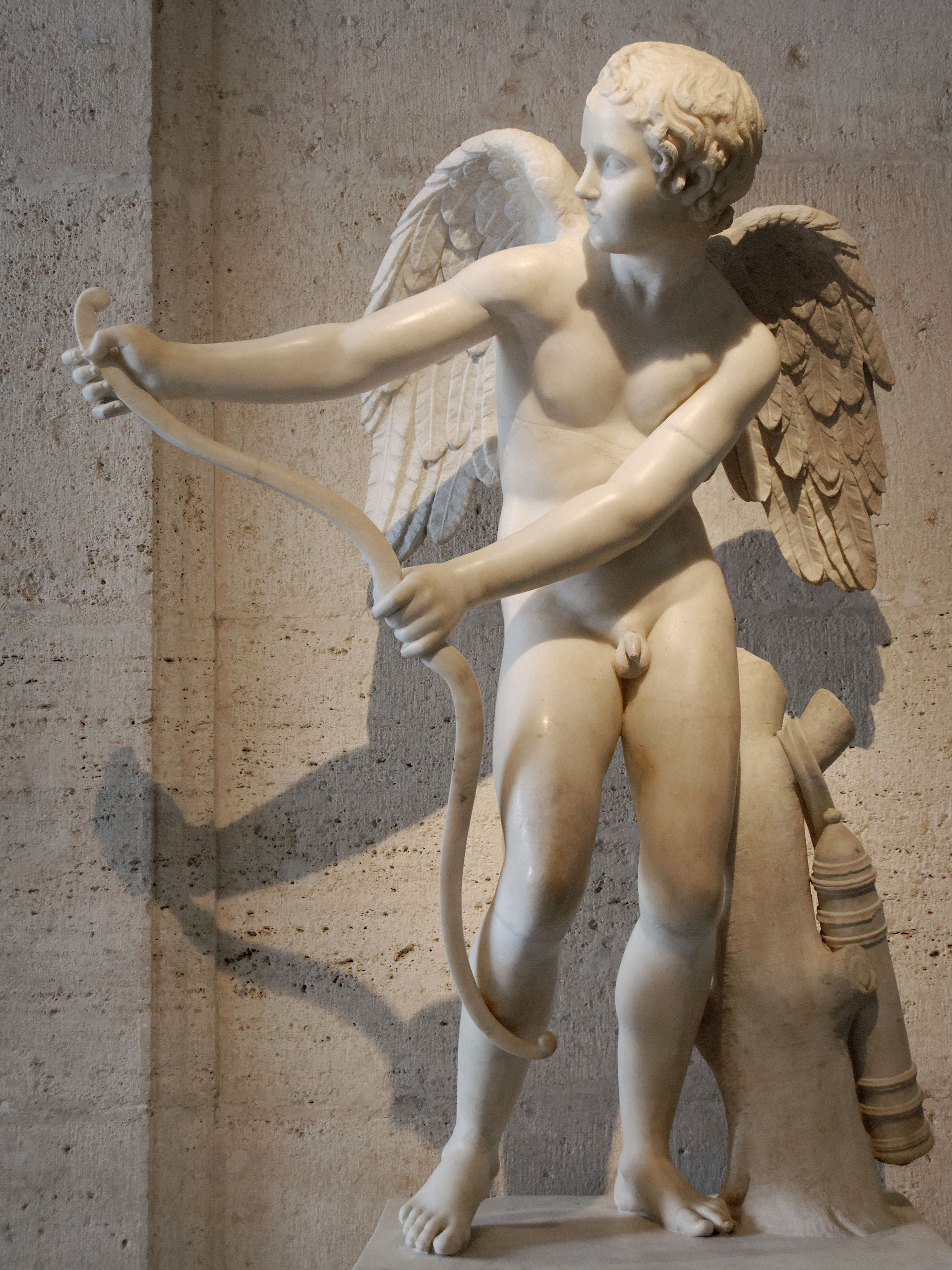 The scene
described by the speaker features banners adorned with fruit-bearing vines
and a standard depicting a golden "Cupidon," an alternate name for the Roman
god of love, Cupid. The use of Cupidon in this context evokes themes of
desire, fertility, and the pursuit of romantic love. The image of Cupidon
peeking out from behind the banner may also imply a sense of voyeurism or
hidden desire, contributing to an undercurrent of sexual tension in the
scene. This lush, sensual imagery is suggestive of the speaker's heightened
sensibility, and highlights the poem's themes of passion and desire. The
image included here, via Wikipedia, shows a Roman copy of an original Greek sculpture of
Eros Stringing His Bow.
- [ZO]philomelAn allusion to the ancient Greek story of Philomela,
which was recounted in Ovid's Metamorphoses 6.412-674. In the story, Tereus, King of
Thrace, marries the Athenian Procne. Procne asks her husband to bring her
sister, Philomela, to visit her in Thrace. Tereus rapes Philomela, and to
keep her from telling her sister of the assault, he cuts out her tongue.
Philomela communicates her story to Procne by weaving a tapestry showing the
events. The two sisters avenge the abuse by killing Itys, Procne and Tereus'
son, and baking him into a pie which Tereus eats. The women flee, pursued by
Tereus; the gods transform the three into birds--Philomela becomes the
sweet-singing nightingale. - [TH]pearlsThroughout The Waste Land,
Eliot refers to Shakespeare's The Tempest. This is an allusion to I.ii.394-398, when
Ariel sings about a drowned man undergoing "a sea-change / Into something
rich and strange." The words suggest the fate of Ferdinand's father, whom he
believes lost at sea. - [TH]ragThough Eliot
has made changes to the language, That Shakespearian Rag is
a ragtime tune from 1912 (Parker, "Songs in T.S. Eliot's The Waste Land"). Ragtime was a projenitor
of jazz, the rhythms of which influenced Eliot's style. - [TH]demobbedColloquial British expression for "demobilized,"
specifically, released from military service. Lil's husband likely served in
World War I (1914-1918). - [TH]hurryThe
barkeep is informing the patrons of closing time. - [TH]pillsThe speaker
is referring to medication that induces abortion. - [TH]spenserAn allusion to Edmund Spenser's poem "Prothalamion" (1596), which celebrates the marriage of two
"nymphs." Nymphs are female water spirits of classical myth, but the word
also suggests young women in general. A prothalamion is a type of poem that
celebrates a coming marriage. - [TH]Verlaine
In this line, the speaker directly
alludes to the last line of the French poet Paul Verlaine’s sonnet
"Parsifal": "And, O those children's voices singing in the dome!" The sonnet
is a meditation on art and the power of music; it reflects the poet's
response to hearing Richard Wagner's opera Parsifal, which is a
major intertext to Eliot's poem. The use of this allusion adds an extra
layer of meaning to the poem. The inclusion of French in the midst of an
English poem could also suggest a sense of cultural dislocation or
separation. Additionally, the image of children's voices singing in a dome
may represent a symbol of purity and innocence that contrasts with the
themes of corruption and decay present elsewhere in the poem. To learn more
about Verlaine, see the Poetry
Foundation. To learn more about Wagner's role in "The Waste Land,"
see this scholarly essay by Philip Waldron, "The Music of Poetry:
Wagner in The Waste Land.". You can read
Verlaine's poem in the original French and in English translation here.
- [ZO]tiresiasIn Greek mythology, Tiresias is a blind prophet who also lived as both a
man and a woman. He was instrumental in the action of Sophocles' Oedipus
plays, and he also appeared in Homer's Odyssey. - [TH]carbuncular
Used here as an adjective, "carbuncular" comes from the word "carbuncle,"
which is an lesion on the skin that is irritated and filled with pus, and
overall is unpleasant to look at (OED n3).
- [CP]Moorgate
The scene
described by the speaker features banners adorned with fruit-bearing vines
and a standard depicting a golden "Cupidon," an alternate name for the Roman
god of love, Cupid. The use of Cupidon in this context evokes themes of
desire, fertility, and the pursuit of romantic love. The image of Cupidon
peeking out from behind the banner may also imply a sense of voyeurism or
hidden desire, contributing to an undercurrent of sexual tension in the
scene. This lush, sensual imagery is suggestive of the speaker's heightened
sensibility, and highlights the poem's themes of passion and desire. The
image included here, via Wikipedia, shows a Roman copy of an original Greek sculpture of
Eros Stringing His Bow.
- [ZO]philomelAn allusion to the ancient Greek story of Philomela,
which was recounted in Ovid's Metamorphoses 6.412-674. In the story, Tereus, King of
Thrace, marries the Athenian Procne. Procne asks her husband to bring her
sister, Philomela, to visit her in Thrace. Tereus rapes Philomela, and to
keep her from telling her sister of the assault, he cuts out her tongue.
Philomela communicates her story to Procne by weaving a tapestry showing the
events. The two sisters avenge the abuse by killing Itys, Procne and Tereus'
son, and baking him into a pie which Tereus eats. The women flee, pursued by
Tereus; the gods transform the three into birds--Philomela becomes the
sweet-singing nightingale. - [TH]pearlsThroughout The Waste Land,
Eliot refers to Shakespeare's The Tempest. This is an allusion to I.ii.394-398, when
Ariel sings about a drowned man undergoing "a sea-change / Into something
rich and strange." The words suggest the fate of Ferdinand's father, whom he
believes lost at sea. - [TH]ragThough Eliot
has made changes to the language, That Shakespearian Rag is
a ragtime tune from 1912 (Parker, "Songs in T.S. Eliot's The Waste Land"). Ragtime was a projenitor
of jazz, the rhythms of which influenced Eliot's style. - [TH]demobbedColloquial British expression for "demobilized,"
specifically, released from military service. Lil's husband likely served in
World War I (1914-1918). - [TH]hurryThe
barkeep is informing the patrons of closing time. - [TH]pillsThe speaker
is referring to medication that induces abortion. - [TH]spenserAn allusion to Edmund Spenser's poem "Prothalamion" (1596), which celebrates the marriage of two
"nymphs." Nymphs are female water spirits of classical myth, but the word
also suggests young women in general. A prothalamion is a type of poem that
celebrates a coming marriage. - [TH]Verlaine
In this line, the speaker directly
alludes to the last line of the French poet Paul Verlaine’s sonnet
"Parsifal": "And, O those children's voices singing in the dome!" The sonnet
is a meditation on art and the power of music; it reflects the poet's
response to hearing Richard Wagner's opera Parsifal, which is a
major intertext to Eliot's poem. The use of this allusion adds an extra
layer of meaning to the poem. The inclusion of French in the midst of an
English poem could also suggest a sense of cultural dislocation or
separation. Additionally, the image of children's voices singing in a dome
may represent a symbol of purity and innocence that contrasts with the
themes of corruption and decay present elsewhere in the poem. To learn more
about Verlaine, see the Poetry
Foundation. To learn more about Wagner's role in "The Waste Land,"
see this scholarly essay by Philip Waldron, "The Music of Poetry:
Wagner in The Waste Land.". You can read
Verlaine's poem in the original French and in English translation here.
- [ZO]tiresiasIn Greek mythology, Tiresias is a blind prophet who also lived as both a
man and a woman. He was instrumental in the action of Sophocles' Oedipus
plays, and he also appeared in Homer's Odyssey. - [TH]carbuncular
Used here as an adjective, "carbuncular" comes from the word "carbuncle,"
which is an lesion on the skin that is irritated and filled with pus, and
overall is unpleasant to look at (OED n3).
- [CP]Moorgate
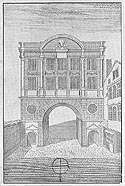 Dating back to the Medieval period,
Moorgate was the last of the old gates to be built in the Roman defense wall
that surrounded the fort of Londinium, now London. The original Roman walls
were built 100-400 CE, but Moorgate was originally a secondary gate that was
expanded in 1415. It led to the marshy Moorfields area in the north of
London. It was demolished in 1762. To learn more about the London Wall, see
Wikipedia. The image here, also via Wikipedia, shows an
18th-century engraving depicting Moorgate before it was demolished.
- [CP]Carthage
Dating back to the Medieval period,
Moorgate was the last of the old gates to be built in the Roman defense wall
that surrounded the fort of Londinium, now London. The original Roman walls
were built 100-400 CE, but Moorgate was originally a secondary gate that was
expanded in 1415. It led to the marshy Moorfields area in the north of
London. It was demolished in 1762. To learn more about the London Wall, see
Wikipedia. The image here, also via Wikipedia, shows an
18th-century engraving depicting Moorgate before it was demolished.
- [CP]Carthage
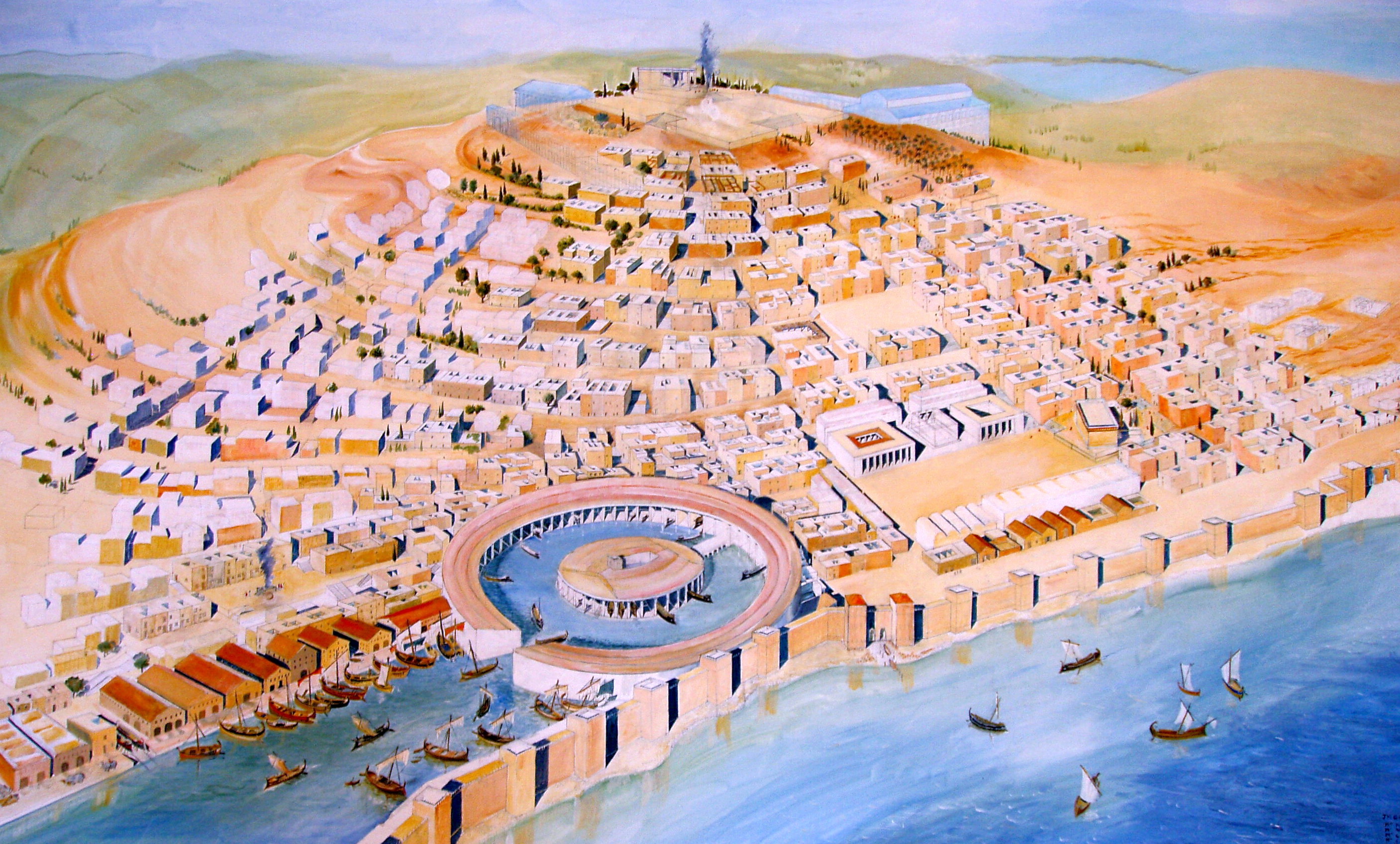 This is a reference to the ancient city of Carthage, which was located in
what is now Tunisia. Carthage was a major center of trade and civilization
in the ancient Mediterranean world, but it was destroyed by the Romans in
the Punic Wars in the 2nd century BCE. The use of Carthage in the poem may
suggest themes of destruction, decay, and the decline of civilization. The
city of Carthage has been interpreted as a symbol of the failure and fall of
human civilizations, which can serve as a warning for modern society. The
image included in this annotation, via Wikimedia Commons, shows
a representation of the ancient city from the Carthage National Museum in
Tunisia.
- [ZO]
This is a reference to the ancient city of Carthage, which was located in
what is now Tunisia. Carthage was a major center of trade and civilization
in the ancient Mediterranean world, but it was destroyed by the Romans in
the Punic Wars in the 2nd century BCE. The use of Carthage in the poem may
suggest themes of destruction, decay, and the decline of civilization. The
city of Carthage has been interpreted as a symbol of the failure and fall of
human civilizations, which can serve as a warning for modern society. The
image included in this annotation, via Wikimedia Commons, shows
a representation of the ancient city from the Carthage National Museum in
Tunisia.
- [ZO]
 These lines are quoted from Richard Wagner's Tristan und
Isolde (1865), a German opera based on a 12th century chivalric tragic
poem Tristan and Iseult. There are multiple different
versions of the story, but at root, it is a Celtic legend about tragic love; the
knight Tristan has been tasked with accompanying the Irish maiden Iseult to be
married to his uncle, the King of Cornwall. On the way, Tristan and Iseult fall
deeply in love, which causes many tempestuous problems. The story became very
popular in the ninteenth and early twentieth centuries, especially among the
Pre-Raphaelites, a group of artists and writers influenced by Romanticism who
sought inspiration in Italian Renaissance art and medieval courtly themes. The
image included here, by the Pre-Raphaelite painter John William Waterhouse, is Tristan and Isolde with the Potion (1916), via Wikimedia Commons. Tristan and Iseult are on the ship heading for
Cornwall and Iseult's marriage; they are drinking a love potion. The lines are
from the first act of Tristan und Isolde, and are sung by
an anonymous sailor about his lover, left behind in Ireland. Translated, the lines
read "Fresh blows the wind / homeward: / my Irish maid, / where do you linger?" A
later line (42, below) from the same opera, "Empty and desolate is the sea,"
sandwiches Eliot's description of the first meeting between the "hyacinth girl"
(36) and her lover, who remembers being struck by her and feeling "neither /
Living nor dead" (39-40). ( - [TH]clairvoyant
This noun comes from the word "clairvoyance", which in the French means
clear-sighted. A clairvoyant is what we would now call a psychic, someone
who can see things that are not physically there. Madame Sosostris is a
fortune teller who has a reputation as "the wisest woman in Europe." The -e
is added to the word clairvoyant to make it feminine in the French (OED).
- [CP]cardsA character in Eliot's poem visits a famous fortune
teller, and the following lines describe the tarot cards she received at a
reading. According to Elizabeth DeBold of the Folger Shakespeare Library, tarot originated in 14th-century
Egypt, and traveled to Europe during the Renaissance. - [TH]water
Water is a prevalent motif throughout The Waste
Land. Water is often associated with regeneration/rebirth, but here and
elsewhere, it is associated with death.
- [CP]woolnoth
These lines are quoted from Richard Wagner's Tristan und
Isolde (1865), a German opera based on a 12th century chivalric tragic
poem Tristan and Iseult. There are multiple different
versions of the story, but at root, it is a Celtic legend about tragic love; the
knight Tristan has been tasked with accompanying the Irish maiden Iseult to be
married to his uncle, the King of Cornwall. On the way, Tristan and Iseult fall
deeply in love, which causes many tempestuous problems. The story became very
popular in the ninteenth and early twentieth centuries, especially among the
Pre-Raphaelites, a group of artists and writers influenced by Romanticism who
sought inspiration in Italian Renaissance art and medieval courtly themes. The
image included here, by the Pre-Raphaelite painter John William Waterhouse, is Tristan and Isolde with the Potion (1916), via Wikimedia Commons. Tristan and Iseult are on the ship heading for
Cornwall and Iseult's marriage; they are drinking a love potion. The lines are
from the first act of Tristan und Isolde, and are sung by
an anonymous sailor about his lover, left behind in Ireland. Translated, the lines
read "Fresh blows the wind / homeward: / my Irish maid, / where do you linger?" A
later line (42, below) from the same opera, "Empty and desolate is the sea,"
sandwiches Eliot's description of the first meeting between the "hyacinth girl"
(36) and her lover, who remembers being struck by her and feeling "neither /
Living nor dead" (39-40). ( - [TH]clairvoyant
This noun comes from the word "clairvoyance", which in the French means
clear-sighted. A clairvoyant is what we would now call a psychic, someone
who can see things that are not physically there. Madame Sosostris is a
fortune teller who has a reputation as "the wisest woman in Europe." The -e
is added to the word clairvoyant to make it feminine in the French (OED).
- [CP]cardsA character in Eliot's poem visits a famous fortune
teller, and the following lines describe the tarot cards she received at a
reading. According to Elizabeth DeBold of the Folger Shakespeare Library, tarot originated in 14th-century
Egypt, and traveled to Europe during the Renaissance. - [TH]water
Water is a prevalent motif throughout The Waste
Land. Water is often associated with regeneration/rebirth, but here and
elsewhere, it is associated with death.
- [CP]woolnoth Saint Mary
Woolnoth is an Anglican church in London, first built in the 12th century,
then rebuilt on several occasions. The photograph included here, from about
1900, originally from the Library of Congress, shows the church in its
modern form, designed by Nicholas Hawksmoore and opened in 1727. This is
likely very close to what Eliot would have seen. It is possible that the
site had been a place of worship for 2000 years (Wikipedia).
- [TH]mylaeThe Battle of
Mylae, a naval battle won in 260BCE by Roman naval
forces. - [TH]baudelaireThis is an allusion to the last line of Charles
Baudelaire's introductory poem "Au Lecteur [To the Reader]" from his
collection Fleurs du mal [Flowers of Evil
(1857-1868). The line reads, "Hypocritical reader, --my twin, --my
brother!" You can read Baudelaire's poems online. - [TH]cupidon
Saint Mary
Woolnoth is an Anglican church in London, first built in the 12th century,
then rebuilt on several occasions. The photograph included here, from about
1900, originally from the Library of Congress, shows the church in its
modern form, designed by Nicholas Hawksmoore and opened in 1727. This is
likely very close to what Eliot would have seen. It is possible that the
site had been a place of worship for 2000 years (Wikipedia).
- [TH]mylaeThe Battle of
Mylae, a naval battle won in 260BCE by Roman naval
forces. - [TH]baudelaireThis is an allusion to the last line of Charles
Baudelaire's introductory poem "Au Lecteur [To the Reader]" from his
collection Fleurs du mal [Flowers of Evil
(1857-1868). The line reads, "Hypocritical reader, --my twin, --my
brother!" You can read Baudelaire's poems online. - [TH]cupidon
 The scene
described by the speaker features banners adorned with fruit-bearing vines
and a standard depicting a golden "Cupidon," an alternate name for the Roman
god of love, Cupid. The use of Cupidon in this context evokes themes of
desire, fertility, and the pursuit of romantic love. The image of Cupidon
peeking out from behind the banner may also imply a sense of voyeurism or
hidden desire, contributing to an undercurrent of sexual tension in the
scene. This lush, sensual imagery is suggestive of the speaker's heightened
sensibility, and highlights the poem's themes of passion and desire. The
image included here, via Wikipedia, shows a Roman copy of an original Greek sculpture of
Eros Stringing His Bow.
- [ZO]philomelAn allusion to the ancient Greek story of Philomela,
which was recounted in Ovid's Metamorphoses 6.412-674. In the story, Tereus, King of
Thrace, marries the Athenian Procne. Procne asks her husband to bring her
sister, Philomela, to visit her in Thrace. Tereus rapes Philomela, and to
keep her from telling her sister of the assault, he cuts out her tongue.
Philomela communicates her story to Procne by weaving a tapestry showing the
events. The two sisters avenge the abuse by killing Itys, Procne and Tereus'
son, and baking him into a pie which Tereus eats. The women flee, pursued by
Tereus; the gods transform the three into birds--Philomela becomes the
sweet-singing nightingale. - [TH]pearlsThroughout The Waste Land,
Eliot refers to Shakespeare's The Tempest. This is an allusion to I.ii.394-398, when
Ariel sings about a drowned man undergoing "a sea-change / Into something
rich and strange." The words suggest the fate of Ferdinand's father, whom he
believes lost at sea. - [TH]ragThough Eliot
has made changes to the language, That Shakespearian Rag is
a ragtime tune from 1912 (Parker, "Songs in T.S. Eliot's The Waste Land"). Ragtime was a projenitor
of jazz, the rhythms of which influenced Eliot's style. - [TH]demobbedColloquial British expression for "demobilized,"
specifically, released from military service. Lil's husband likely served in
World War I (1914-1918). - [TH]hurryThe
barkeep is informing the patrons of closing time. - [TH]pillsThe speaker
is referring to medication that induces abortion. - [TH]spenserAn allusion to Edmund Spenser's poem "Prothalamion" (1596), which celebrates the marriage of two
"nymphs." Nymphs are female water spirits of classical myth, but the word
also suggests young women in general. A prothalamion is a type of poem that
celebrates a coming marriage. - [TH]Verlaine
In this line, the speaker directly
alludes to the last line of the French poet Paul Verlaine’s sonnet
"Parsifal": "And, O those children's voices singing in the dome!" The sonnet
is a meditation on art and the power of music; it reflects the poet's
response to hearing Richard Wagner's opera Parsifal, which is a
major intertext to Eliot's poem. The use of this allusion adds an extra
layer of meaning to the poem. The inclusion of French in the midst of an
English poem could also suggest a sense of cultural dislocation or
separation. Additionally, the image of children's voices singing in a dome
may represent a symbol of purity and innocence that contrasts with the
themes of corruption and decay present elsewhere in the poem. To learn more
about Verlaine, see the Poetry
Foundation. To learn more about Wagner's role in "The Waste Land,"
see this scholarly essay by Philip Waldron, "The Music of Poetry:
Wagner in The Waste Land.". You can read
Verlaine's poem in the original French and in English translation here.
- [ZO]tiresiasIn Greek mythology, Tiresias is a blind prophet who also lived as both a
man and a woman. He was instrumental in the action of Sophocles' Oedipus
plays, and he also appeared in Homer's Odyssey. - [TH]carbuncular
Used here as an adjective, "carbuncular" comes from the word "carbuncle,"
which is an lesion on the skin that is irritated and filled with pus, and
overall is unpleasant to look at (OED n3).
- [CP]Moorgate
The scene
described by the speaker features banners adorned with fruit-bearing vines
and a standard depicting a golden "Cupidon," an alternate name for the Roman
god of love, Cupid. The use of Cupidon in this context evokes themes of
desire, fertility, and the pursuit of romantic love. The image of Cupidon
peeking out from behind the banner may also imply a sense of voyeurism or
hidden desire, contributing to an undercurrent of sexual tension in the
scene. This lush, sensual imagery is suggestive of the speaker's heightened
sensibility, and highlights the poem's themes of passion and desire. The
image included here, via Wikipedia, shows a Roman copy of an original Greek sculpture of
Eros Stringing His Bow.
- [ZO]philomelAn allusion to the ancient Greek story of Philomela,
which was recounted in Ovid's Metamorphoses 6.412-674. In the story, Tereus, King of
Thrace, marries the Athenian Procne. Procne asks her husband to bring her
sister, Philomela, to visit her in Thrace. Tereus rapes Philomela, and to
keep her from telling her sister of the assault, he cuts out her tongue.
Philomela communicates her story to Procne by weaving a tapestry showing the
events. The two sisters avenge the abuse by killing Itys, Procne and Tereus'
son, and baking him into a pie which Tereus eats. The women flee, pursued by
Tereus; the gods transform the three into birds--Philomela becomes the
sweet-singing nightingale. - [TH]pearlsThroughout The Waste Land,
Eliot refers to Shakespeare's The Tempest. This is an allusion to I.ii.394-398, when
Ariel sings about a drowned man undergoing "a sea-change / Into something
rich and strange." The words suggest the fate of Ferdinand's father, whom he
believes lost at sea. - [TH]ragThough Eliot
has made changes to the language, That Shakespearian Rag is
a ragtime tune from 1912 (Parker, "Songs in T.S. Eliot's The Waste Land"). Ragtime was a projenitor
of jazz, the rhythms of which influenced Eliot's style. - [TH]demobbedColloquial British expression for "demobilized,"
specifically, released from military service. Lil's husband likely served in
World War I (1914-1918). - [TH]hurryThe
barkeep is informing the patrons of closing time. - [TH]pillsThe speaker
is referring to medication that induces abortion. - [TH]spenserAn allusion to Edmund Spenser's poem "Prothalamion" (1596), which celebrates the marriage of two
"nymphs." Nymphs are female water spirits of classical myth, but the word
also suggests young women in general. A prothalamion is a type of poem that
celebrates a coming marriage. - [TH]Verlaine
In this line, the speaker directly
alludes to the last line of the French poet Paul Verlaine’s sonnet
"Parsifal": "And, O those children's voices singing in the dome!" The sonnet
is a meditation on art and the power of music; it reflects the poet's
response to hearing Richard Wagner's opera Parsifal, which is a
major intertext to Eliot's poem. The use of this allusion adds an extra
layer of meaning to the poem. The inclusion of French in the midst of an
English poem could also suggest a sense of cultural dislocation or
separation. Additionally, the image of children's voices singing in a dome
may represent a symbol of purity and innocence that contrasts with the
themes of corruption and decay present elsewhere in the poem. To learn more
about Verlaine, see the Poetry
Foundation. To learn more about Wagner's role in "The Waste Land,"
see this scholarly essay by Philip Waldron, "The Music of Poetry:
Wagner in The Waste Land.". You can read
Verlaine's poem in the original French and in English translation here.
- [ZO]tiresiasIn Greek mythology, Tiresias is a blind prophet who also lived as both a
man and a woman. He was instrumental in the action of Sophocles' Oedipus
plays, and he also appeared in Homer's Odyssey. - [TH]carbuncular
Used here as an adjective, "carbuncular" comes from the word "carbuncle,"
which is an lesion on the skin that is irritated and filled with pus, and
overall is unpleasant to look at (OED n3).
- [CP]Moorgate
 Dating back to the Medieval period,
Moorgate was the last of the old gates to be built in the Roman defense wall
that surrounded the fort of Londinium, now London. The original Roman walls
were built 100-400 CE, but Moorgate was originally a secondary gate that was
expanded in 1415. It led to the marshy Moorfields area in the north of
London. It was demolished in 1762. To learn more about the London Wall, see
Wikipedia. The image here, also via Wikipedia, shows an
18th-century engraving depicting Moorgate before it was demolished.
- [CP]Carthage
Dating back to the Medieval period,
Moorgate was the last of the old gates to be built in the Roman defense wall
that surrounded the fort of Londinium, now London. The original Roman walls
were built 100-400 CE, but Moorgate was originally a secondary gate that was
expanded in 1415. It led to the marshy Moorfields area in the north of
London. It was demolished in 1762. To learn more about the London Wall, see
Wikipedia. The image here, also via Wikipedia, shows an
18th-century engraving depicting Moorgate before it was demolished.
- [CP]Carthage
 This is a reference to the ancient city of Carthage, which was located in
what is now Tunisia. Carthage was a major center of trade and civilization
in the ancient Mediterranean world, but it was destroyed by the Romans in
the Punic Wars in the 2nd century BCE. The use of Carthage in the poem may
suggest themes of destruction, decay, and the decline of civilization. The
city of Carthage has been interpreted as a symbol of the failure and fall of
human civilizations, which can serve as a warning for modern society. The
image included in this annotation, via Wikimedia Commons, shows
a representation of the ancient city from the Carthage National Museum in
Tunisia.
- [ZO]
This is a reference to the ancient city of Carthage, which was located in
what is now Tunisia. Carthage was a major center of trade and civilization
in the ancient Mediterranean world, but it was destroyed by the Romans in
the Punic Wars in the 2nd century BCE. The use of Carthage in the poem may
suggest themes of destruction, decay, and the decline of civilization. The
city of Carthage has been interpreted as a symbol of the failure and fall of
human civilizations, which can serve as a warning for modern society. The
image included in this annotation, via Wikimedia Commons, shows
a representation of the ancient city from the Carthage National Museum in
Tunisia.
- [ZO][TP]
THE WASTE LAND
BY
T. S. ELIOT
"Nam Sibyllam quidem Cumis ego ipse oculis meis vidi in ampulla pendere, et cum illi pueri dicerent: Σίβυλλα τί θέλεις; respondebat illa: ἀποθανεῖν θέλω." epigraphepigraphThis is a quote from the first-century Roman prose work Satyricon (c.54-68) believed to be by Gaius Petronius (27-66CE). Eliot translated the epigraph as follows: "I saw with my own eyes the Sibyl at Cumae hanging in a cage, and when the boys said to her: 'Sibyl, what do you want?' she answered: 'I want to die.'" - [TH] NEW YORK
BONI AND LIVERIGHT1922
BY
T. S. ELIOT
"Nam Sibyllam quidem Cumis ego ipse oculis meis vidi in ampulla pendere, et cum illi pueri dicerent: Σίβυλλα τί θέλεις; respondebat illa: ἀποθανεῖν θέλω." epigraphepigraphThis is a quote from the first-century Roman prose work Satyricon (c.54-68) believed to be by Gaius Petronius (27-66CE). Eliot translated the epigraph as follows: "I saw with my own eyes the Sibyl at Cumae hanging in a cage, and when the boys said to her: 'Sibyl, what do you want?' she answered: 'I want to die.'" - [TH] NEW YORK
BONI AND LIVERIGHT1922
Footnotes
epigraph_This is a quote from the first-century Roman prose work Satyricon (c.54-68) believed to be by Gaius Petronius
(27-66CE). Eliot translated the epigraph as follows: "I saw with my own eyes
the Sibyl at Cumae hanging in a cage, and when the boys said to her: 'Sibyl,
what do you want?' she answered: 'I want to die.'"
_ChaucerThe first line of The Waste Land alludes to the
General Prologue of Geoffrey Chaucer's Canterbury
Tales, which opens with a "description of Spring characteristic of
dream visions of secular love" (Harvard). Chaucer's poem begins, in modern English, as follows:
When April with its sweet-smelling showers
THas pierced the drought of March to the root,
And bathed every vein (of the plants) in such liquid
By which power the flower is created;
When the West Wind also with its sweet breath
In every wood and field has breathed life into
The tender new leaves, and the young sun
Has run half its course in Aries,
And small fowls make melody,
Those that sleep all the night with open eyes
(So Nature incites them in their hearts),
Then folk long to go on pilgrimages,
And professional pilgrims to seek foreign shores,
To distant shrines, known in various lands.... (General
Prologue, 1-14)
You might consider how Eliot's version compares to
this source text.
_identity
In this passage, the female speaker's statement, "I am not Russian at all; I
come from Lithuania, really German," introduces the theme of fragmentation
and displacement that permeates the poem. The speaker's identity is shaped
by multiple cultural influences, resulting in a fragmented sense of self.
She does not fully identify as Russian, Lithuanian, or German, but as a
hybrid of all three. This complex identity further highlights the themes of
displacement and cultural conflict throughout the work.
Wagner_ These lines are quoted from Richard Wagner's Tristan und
Isolde (1865), a German opera based on a 12th century chivalric tragic
poem Tristan and Iseult. There are multiple different
versions of the story, but at root, it is a Celtic legend about tragic love; the
knight Tristan has been tasked with accompanying the Irish maiden Iseult to be
married to his uncle, the King of Cornwall. On the way, Tristan and Iseult fall
deeply in love, which causes many tempestuous problems. The story became very
popular in the ninteenth and early twentieth centuries, especially among the
Pre-Raphaelites, a group of artists and writers influenced by Romanticism who
sought inspiration in Italian Renaissance art and medieval courtly themes. The
image included here, by the Pre-Raphaelite painter John William Waterhouse, is Tristan and Isolde with the Potion (1916), via Wikimedia Commons. Tristan and Iseult are on the ship heading for
Cornwall and Iseult's marriage; they are drinking a love potion. The lines are
from the first act of Tristan und Isolde, and are sung by
an anonymous sailor about his lover, left behind in Ireland. Translated, the lines
read "Fresh blows the wind / homeward: / my Irish maid, / where do you linger?" A
later line (42, below) from the same opera, "Empty and desolate is the sea,"
sandwiches Eliot's description of the first meeting between the "hyacinth girl"
(36) and her lover, who remembers being struck by her and feeling "neither /
Living nor dead" (39-40). (
These lines are quoted from Richard Wagner's Tristan und
Isolde (1865), a German opera based on a 12th century chivalric tragic
poem Tristan and Iseult. There are multiple different
versions of the story, but at root, it is a Celtic legend about tragic love; the
knight Tristan has been tasked with accompanying the Irish maiden Iseult to be
married to his uncle, the King of Cornwall. On the way, Tristan and Iseult fall
deeply in love, which causes many tempestuous problems. The story became very
popular in the ninteenth and early twentieth centuries, especially among the
Pre-Raphaelites, a group of artists and writers influenced by Romanticism who
sought inspiration in Italian Renaissance art and medieval courtly themes. The
image included here, by the Pre-Raphaelite painter John William Waterhouse, is Tristan and Isolde with the Potion (1916), via Wikimedia Commons. Tristan and Iseult are on the ship heading for
Cornwall and Iseult's marriage; they are drinking a love potion. The lines are
from the first act of Tristan und Isolde, and are sung by
an anonymous sailor about his lover, left behind in Ireland. Translated, the lines
read "Fresh blows the wind / homeward: / my Irish maid, / where do you linger?" A
later line (42, below) from the same opera, "Empty and desolate is the sea,"
sandwiches Eliot's description of the first meeting between the "hyacinth girl"
(36) and her lover, who remembers being struck by her and feeling "neither /
Living nor dead" (39-40). (
 These lines are quoted from Richard Wagner's Tristan und
Isolde (1865), a German opera based on a 12th century chivalric tragic
poem Tristan and Iseult. There are multiple different
versions of the story, but at root, it is a Celtic legend about tragic love; the
knight Tristan has been tasked with accompanying the Irish maiden Iseult to be
married to his uncle, the King of Cornwall. On the way, Tristan and Iseult fall
deeply in love, which causes many tempestuous problems. The story became very
popular in the ninteenth and early twentieth centuries, especially among the
Pre-Raphaelites, a group of artists and writers influenced by Romanticism who
sought inspiration in Italian Renaissance art and medieval courtly themes. The
image included here, by the Pre-Raphaelite painter John William Waterhouse, is Tristan and Isolde with the Potion (1916), via Wikimedia Commons. Tristan and Iseult are on the ship heading for
Cornwall and Iseult's marriage; they are drinking a love potion. The lines are
from the first act of Tristan und Isolde, and are sung by
an anonymous sailor about his lover, left behind in Ireland. Translated, the lines
read "Fresh blows the wind / homeward: / my Irish maid, / where do you linger?" A
later line (42, below) from the same opera, "Empty and desolate is the sea,"
sandwiches Eliot's description of the first meeting between the "hyacinth girl"
(36) and her lover, who remembers being struck by her and feeling "neither /
Living nor dead" (39-40). (
These lines are quoted from Richard Wagner's Tristan und
Isolde (1865), a German opera based on a 12th century chivalric tragic
poem Tristan and Iseult. There are multiple different
versions of the story, but at root, it is a Celtic legend about tragic love; the
knight Tristan has been tasked with accompanying the Irish maiden Iseult to be
married to his uncle, the King of Cornwall. On the way, Tristan and Iseult fall
deeply in love, which causes many tempestuous problems. The story became very
popular in the ninteenth and early twentieth centuries, especially among the
Pre-Raphaelites, a group of artists and writers influenced by Romanticism who
sought inspiration in Italian Renaissance art and medieval courtly themes. The
image included here, by the Pre-Raphaelite painter John William Waterhouse, is Tristan and Isolde with the Potion (1916), via Wikimedia Commons. Tristan and Iseult are on the ship heading for
Cornwall and Iseult's marriage; they are drinking a love potion. The lines are
from the first act of Tristan und Isolde, and are sung by
an anonymous sailor about his lover, left behind in Ireland. Translated, the lines
read "Fresh blows the wind / homeward: / my Irish maid, / where do you linger?" A
later line (42, below) from the same opera, "Empty and desolate is the sea,"
sandwiches Eliot's description of the first meeting between the "hyacinth girl"
(36) and her lover, who remembers being struck by her and feeling "neither /
Living nor dead" (39-40). (_clairvoyant
This noun comes from the word "clairvoyance", which in the French means
clear-sighted. A clairvoyant is what we would now call a psychic, someone
who can see things that are not physically there. Madame Sosostris is a
fortune teller who has a reputation as "the wisest woman in Europe." The -e
is added to the word clairvoyant to make it feminine in the French (OED).
cards_A character in Eliot's poem visits a famous fortune
teller, and the following lines describe the tarot cards she received at a
reading. According to Elizabeth DeBold of the Folger Shakespeare Library, tarot originated in 14th-century
Egypt, and traveled to Europe during the Renaissance.
_water
Water is a prevalent motif throughout The Waste
Land. Water is often associated with regeneration/rebirth, but here and
elsewhere, it is associated with death.
woolnoth_ Saint Mary
Woolnoth is an Anglican church in London, first built in the 12th century,
then rebuilt on several occasions. The photograph included here, from about
1900, originally from the Library of Congress, shows the church in its
modern form, designed by Nicholas Hawksmoore and opened in 1727. This is
likely very close to what Eliot would have seen. It is possible that the
site had been a place of worship for 2000 years (Wikipedia).
Saint Mary
Woolnoth is an Anglican church in London, first built in the 12th century,
then rebuilt on several occasions. The photograph included here, from about
1900, originally from the Library of Congress, shows the church in its
modern form, designed by Nicholas Hawksmoore and opened in 1727. This is
likely very close to what Eliot would have seen. It is possible that the
site had been a place of worship for 2000 years (Wikipedia).
 Saint Mary
Woolnoth is an Anglican church in London, first built in the 12th century,
then rebuilt on several occasions. The photograph included here, from about
1900, originally from the Library of Congress, shows the church in its
modern form, designed by Nicholas Hawksmoore and opened in 1727. This is
likely very close to what Eliot would have seen. It is possible that the
site had been a place of worship for 2000 years (Wikipedia).
Saint Mary
Woolnoth is an Anglican church in London, first built in the 12th century,
then rebuilt on several occasions. The photograph included here, from about
1900, originally from the Library of Congress, shows the church in its
modern form, designed by Nicholas Hawksmoore and opened in 1727. This is
likely very close to what Eliot would have seen. It is possible that the
site had been a place of worship for 2000 years (Wikipedia).
mylae_The Battle of
Mylae, a naval battle won in 260BCE by Roman naval
forces.
baudelaire_This is an allusion to the last line of Charles
Baudelaire's introductory poem "Au Lecteur [To the Reader]" from his
collection Fleurs du mal [Flowers of Evil
(1857-1868). The line reads, "Hypocritical reader, --my twin, --my
brother!" You can read Baudelaire's poems online.
_cupidon
 The scene
described by the speaker features banners adorned with fruit-bearing vines
and a standard depicting a golden "Cupidon," an alternate name for the Roman
god of love, Cupid. The use of Cupidon in this context evokes themes of
desire, fertility, and the pursuit of romantic love. The image of Cupidon
peeking out from behind the banner may also imply a sense of voyeurism or
hidden desire, contributing to an undercurrent of sexual tension in the
scene. This lush, sensual imagery is suggestive of the speaker's heightened
sensibility, and highlights the poem's themes of passion and desire. The
image included here, via Wikipedia, shows a Roman copy of an original Greek sculpture of
Eros Stringing His Bow.
The scene
described by the speaker features banners adorned with fruit-bearing vines
and a standard depicting a golden "Cupidon," an alternate name for the Roman
god of love, Cupid. The use of Cupidon in this context evokes themes of
desire, fertility, and the pursuit of romantic love. The image of Cupidon
peeking out from behind the banner may also imply a sense of voyeurism or
hidden desire, contributing to an undercurrent of sexual tension in the
scene. This lush, sensual imagery is suggestive of the speaker's heightened
sensibility, and highlights the poem's themes of passion and desire. The
image included here, via Wikipedia, shows a Roman copy of an original Greek sculpture of
Eros Stringing His Bow.
 The scene
described by the speaker features banners adorned with fruit-bearing vines
and a standard depicting a golden "Cupidon," an alternate name for the Roman
god of love, Cupid. The use of Cupidon in this context evokes themes of
desire, fertility, and the pursuit of romantic love. The image of Cupidon
peeking out from behind the banner may also imply a sense of voyeurism or
hidden desire, contributing to an undercurrent of sexual tension in the
scene. This lush, sensual imagery is suggestive of the speaker's heightened
sensibility, and highlights the poem's themes of passion and desire. The
image included here, via Wikipedia, shows a Roman copy of an original Greek sculpture of
Eros Stringing His Bow.
The scene
described by the speaker features banners adorned with fruit-bearing vines
and a standard depicting a golden "Cupidon," an alternate name for the Roman
god of love, Cupid. The use of Cupidon in this context evokes themes of
desire, fertility, and the pursuit of romantic love. The image of Cupidon
peeking out from behind the banner may also imply a sense of voyeurism or
hidden desire, contributing to an undercurrent of sexual tension in the
scene. This lush, sensual imagery is suggestive of the speaker's heightened
sensibility, and highlights the poem's themes of passion and desire. The
image included here, via Wikipedia, shows a Roman copy of an original Greek sculpture of
Eros Stringing His Bow.
philomel_An allusion to the ancient Greek story of Philomela,
which was recounted in Ovid's Metamorphoses 6.412-674. In the story, Tereus, King of
Thrace, marries the Athenian Procne. Procne asks her husband to bring her
sister, Philomela, to visit her in Thrace. Tereus rapes Philomela, and to
keep her from telling her sister of the assault, he cuts out her tongue.
Philomela communicates her story to Procne by weaving a tapestry showing the
events. The two sisters avenge the abuse by killing Itys, Procne and Tereus'
son, and baking him into a pie which Tereus eats. The women flee, pursued by
Tereus; the gods transform the three into birds--Philomela becomes the
sweet-singing nightingale.
pearls_Throughout The Waste Land,
Eliot refers to Shakespeare's The Tempest. This is an allusion to I.ii.394-398, when
Ariel sings about a drowned man undergoing "a sea-change / Into something
rich and strange." The words suggest the fate of Ferdinand's father, whom he
believes lost at sea.
rag_Though Eliot
has made changes to the language, That Shakespearian Rag is
a ragtime tune from 1912 (Parker, "Songs in T.S. Eliot's The Waste Land"). Ragtime was a projenitor
of jazz, the rhythms of which influenced Eliot's style.
demobbed_Colloquial British expression for "demobilized,"
specifically, released from military service. Lil's husband likely served in
World War I (1914-1918).
hurry_The
barkeep is informing the patrons of closing time.
pills_The speaker
is referring to medication that induces abortion.
spenser_An allusion to Edmund Spenser's poem "Prothalamion" (1596), which celebrates the marriage of two
"nymphs." Nymphs are female water spirits of classical myth, but the word
also suggests young women in general. A prothalamion is a type of poem that
celebrates a coming marriage.
_Verlaine
In this line, the speaker directly
alludes to the last line of the French poet Paul Verlaine’s sonnet
"Parsifal": "And, O those children's voices singing in the dome!" The sonnet
is a meditation on art and the power of music; it reflects the poet's
response to hearing Richard Wagner's opera Parsifal, which is a
major intertext to Eliot's poem. The use of this allusion adds an extra
layer of meaning to the poem. The inclusion of French in the midst of an
English poem could also suggest a sense of cultural dislocation or
separation. Additionally, the image of children's voices singing in a dome
may represent a symbol of purity and innocence that contrasts with the
themes of corruption and decay present elsewhere in the poem. To learn more
about Verlaine, see the Poetry
Foundation. To learn more about Wagner's role in "The Waste Land,"
see this scholarly essay by Philip Waldron, "The Music of Poetry:
Wagner in The Waste Land.". You can read
Verlaine's poem in the original French and in English translation here.
_tiresiasIn Greek mythology, Tiresias is a blind prophet who also lived as both a
man and a woman. He was instrumental in the action of Sophocles' Oedipus
plays, and he also appeared in Homer's Odyssey.
_carbuncular
Used here as an adjective, "carbuncular" comes from the word "carbuncle,"
which is an lesion on the skin that is irritated and filled with pus, and
overall is unpleasant to look at (OED n3).
_Moorgate
 Dating back to the Medieval period,
Moorgate was the last of the old gates to be built in the Roman defense wall
that surrounded the fort of Londinium, now London. The original Roman walls
were built 100-400 CE, but Moorgate was originally a secondary gate that was
expanded in 1415. It led to the marshy Moorfields area in the north of
London. It was demolished in 1762. To learn more about the London Wall, see
Wikipedia. The image here, also via Wikipedia, shows an
18th-century engraving depicting Moorgate before it was demolished.
Dating back to the Medieval period,
Moorgate was the last of the old gates to be built in the Roman defense wall
that surrounded the fort of Londinium, now London. The original Roman walls
were built 100-400 CE, but Moorgate was originally a secondary gate that was
expanded in 1415. It led to the marshy Moorfields area in the north of
London. It was demolished in 1762. To learn more about the London Wall, see
Wikipedia. The image here, also via Wikipedia, shows an
18th-century engraving depicting Moorgate before it was demolished.
 Dating back to the Medieval period,
Moorgate was the last of the old gates to be built in the Roman defense wall
that surrounded the fort of Londinium, now London. The original Roman walls
were built 100-400 CE, but Moorgate was originally a secondary gate that was
expanded in 1415. It led to the marshy Moorfields area in the north of
London. It was demolished in 1762. To learn more about the London Wall, see
Wikipedia. The image here, also via Wikipedia, shows an
18th-century engraving depicting Moorgate before it was demolished.
Dating back to the Medieval period,
Moorgate was the last of the old gates to be built in the Roman defense wall
that surrounded the fort of Londinium, now London. The original Roman walls
were built 100-400 CE, but Moorgate was originally a secondary gate that was
expanded in 1415. It led to the marshy Moorfields area in the north of
London. It was demolished in 1762. To learn more about the London Wall, see
Wikipedia. The image here, also via Wikipedia, shows an
18th-century engraving depicting Moorgate before it was demolished.
_Carthage
 This is a reference to the ancient city of Carthage, which was located in
what is now Tunisia. Carthage was a major center of trade and civilization
in the ancient Mediterranean world, but it was destroyed by the Romans in
the Punic Wars in the 2nd century BCE. The use of Carthage in the poem may
suggest themes of destruction, decay, and the decline of civilization. The
city of Carthage has been interpreted as a symbol of the failure and fall of
human civilizations, which can serve as a warning for modern society. The
image included in this annotation, via Wikimedia Commons, shows
a representation of the ancient city from the Carthage National Museum in
Tunisia.
This is a reference to the ancient city of Carthage, which was located in
what is now Tunisia. Carthage was a major center of trade and civilization
in the ancient Mediterranean world, but it was destroyed by the Romans in
the Punic Wars in the 2nd century BCE. The use of Carthage in the poem may
suggest themes of destruction, decay, and the decline of civilization. The
city of Carthage has been interpreted as a symbol of the failure and fall of
human civilizations, which can serve as a warning for modern society. The
image included in this annotation, via Wikimedia Commons, shows
a representation of the ancient city from the Carthage National Museum in
Tunisia.
 This is a reference to the ancient city of Carthage, which was located in
what is now Tunisia. Carthage was a major center of trade and civilization
in the ancient Mediterranean world, but it was destroyed by the Romans in
the Punic Wars in the 2nd century BCE. The use of Carthage in the poem may
suggest themes of destruction, decay, and the decline of civilization. The
city of Carthage has been interpreted as a symbol of the failure and fall of
human civilizations, which can serve as a warning for modern society. The
image included in this annotation, via Wikimedia Commons, shows
a representation of the ancient city from the Carthage National Museum in
Tunisia.
This is a reference to the ancient city of Carthage, which was located in
what is now Tunisia. Carthage was a major center of trade and civilization
in the ancient Mediterranean world, but it was destroyed by the Romans in
the Punic Wars in the 2nd century BCE. The use of Carthage in the poem may
suggest themes of destruction, decay, and the decline of civilization. The
city of Carthage has been interpreted as a symbol of the failure and fall of
human civilizations, which can serve as a warning for modern society. The
image included in this annotation, via Wikimedia Commons, shows
a representation of the ancient city from the Carthage National Museum in
Tunisia.
![Page [TP]](https://anthologyassetsdev.lib.virginia.edu/eliot-waste-land/pageImages/wasteland01elio_Page_09.jpg)
